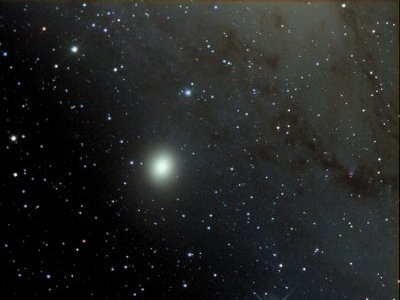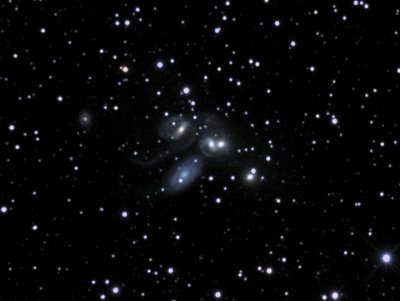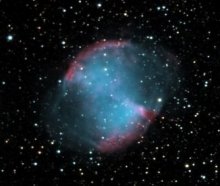 |
Galaxies |
| |
By Messier Number
M31,
M32,
M32 (WF),
M33, M33 (WF), M51,
M65,
M66,
M74, M63, M77,
M81,
M81 Group (WF),
M82, M83,
M84,
M86,
M87,
M90, M91, By NGC Number By IC Number
10, 239,
342,
356, 1613,
1727,
2604 and 2608
1,
9,
14, 26,
29,
37, 76,
77,
78,
82, 85,
86,
94,
104,
105,
120,
135,
141, 153,
157, 168,
184, 189,
206,
210, 213,
214,
215, 222, 223, By Other Catalog Number or Designation
Antennae,
Box,
Cartwheel (ESO 350-40),
Helix,
Hickson 92,
Markarian's Chain,
Stephan's Quintet,
UGC 1195,
UGC 3730,
|
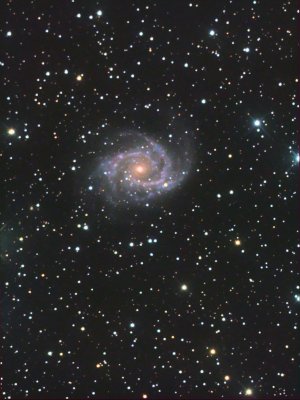 NGC 2997
NGC 299710-inch Newtonian, ST2000XM, 60/20/20/20 NGC 2997 is a beautiful "Grand Design" spiral (SAB(rs)c) found in the southern constellation Antila. It doesn't get as much attention as it deserves because of it's low declination (-31 degrees). It is relatively nearby at approximately 25 million light years, but there is a lot of variation in the distance results. Megastar lists the magnitude as 10.1 and the size as 9.2' x 7.4'. Again, there is variation in the published measurements but these are fairly typical. My data for this image was sharp but noisy. Al Kelly worked his processing magic to get this result. It is much better than my processing.
|
|
|
|
|
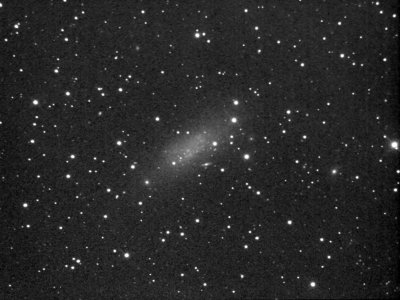 UGC 12613 (Pegasus Dwarf Irregular) 10-inch Newtonian, ST2000XM, 120 UGC 12613 is a dwarf irregular galaxy; there is a second dwarf in Pegasus which is spheroidal. Both are members of the Local Group, the most prominent members of which are the Andromeda Galaxy (M31), the Triangulum Galaxy (M33), and the Milky Way. UGC 12613 is just a bit more distant than M31, at 3.0 million light years versus 2.6 for M31. The image appears to show some resolution into stars, and there may be some supergiants seen, but most of the apparent stars are compact open clusters or star forming regions. Note the large number of companion and/or background galaxies in the vicinity of the Dwarf. This is one of the few monochrome images on the site. It is so faint that I decided it would be more useful to collect additional luminance data instead of color data which would be very noisy anyway. |
|
|
|
|
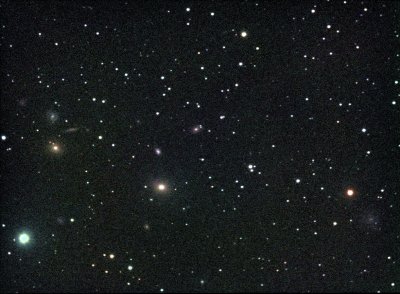
Celestron CG 9 1/4, ST2000XM, 88/28/28/28 This image is from my home and was a bit of an experiment. I wanted to see if I could successfully image fainter galaxies with the level of light pollution I have here. The answer is "sort of". The background noise in the image is severe and makes it very hard to bring out the fainter structure. But the galaxies are visible and the structure can be seen. In the future, I plan to limit my home images to clusters, bright galaxies, and narrow band objects. Still plenty of targets. There are 7 members of the group, although one has been questioned.
1060 is the S0- just below center and 1066, near the left side, is an E.
The nearly edge-on just above 1066 is 1062, an Sd, and and the obvious
spiral a little further N is 1067, classified as SAB(s)c. Back to
the center, just above 1060, is the I? 1061, and a bit higher and to the
right is 1057, an S0. Finally, the questionable member is the |
|
|
|
|
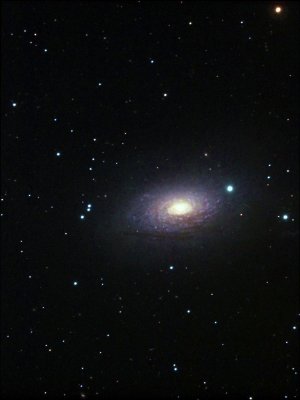
Celestron CG 9 1/4 inch, ST2000XM, 84:28:28:28 This was my first image at TSP 2016. It was done with my 20-year old CG 9 1/4 and a new iOptron 45 Pro mount that I purchased about three weeks before TSP. I was delighted with the combination. M63 is often called the Sunflower Galaxy, and the reason is obvious. It is a flocculent spiral with a very short bar. The contrast between the yellow central region and the blue arms is strong. The flocculent nature of the arms makes them very hard to trace. |
|
|
|
|
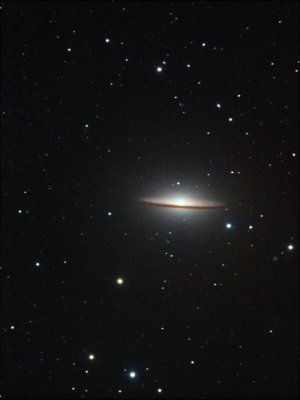
Celestron CG 9 1/4 inch, ST2000XM, 60:20:20:20 Another image from TSP 2016. M104 is widely known as the Sombrero Galaxy. We are viewing it very nearly edge-on. The well-defined dust lane is its most obvious feature. There is a supermassive black hole at the core, one of the largest among the nearby galaxies, even though 104 is only about 30% of the size of the Milky Way. It has a large number of globular clusters, with the total now approaching 2000. M104 is in an area rich in galaxies. Most of the fainter objects in the image are galaxies, not stars. The ratio is probably 3 or 4 to 1. This is best seen in the Full size image. |
|
|
|
|
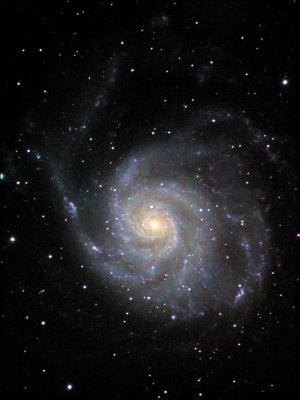
Celestron CG 9 1/4 inch, ST2000XM, 60:24:24:24 This is the third of my five images from TSP 2016. M101 is also known as the Pinwheel Galaxy. It is a face-on, "grand design" spiral, but it has been distorted by interaction with one or more of its companions. These are NGC 5204, 5474, 5477, 5585, and Holmberg IV. None fall within this field. It has many bright H II regions, ten of which have their own NGC numbers. M101 is comparable in size to our Milky Way. M101 is also included in the Arp catalog as Arp 26, where it is placed in the class "Spiral with one heavy arm". |
|
|
|
|
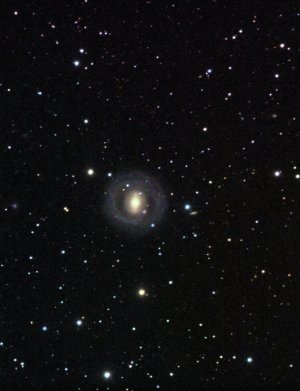
Celestron CG 9 1/4 inch, ST2000XM, 84:24:24:24 Another image from TSP 2016. This is an unusual galaxy. It has a very strong bar and a ring or pseudo-ring. The classification is (R)SB0/a(rs). To me, the ring does not seem completely separated from the bar and central region. I can see it as a faint arm, starting at the south end of the bar and forming an almost complete circle, but not quite meeting the starting point to make a full ring. You can find an article discussing simulations of ring formation, with some discussion of NGC 5701 in particular, at: http://mnras.oxfordjournals.org/content/395/1/537.full.pdf In addition to the obvious little galaxy to the right of 5701, very near the bright star, several others can either be seen through the ring or are in front of it. |
|
|
|
|
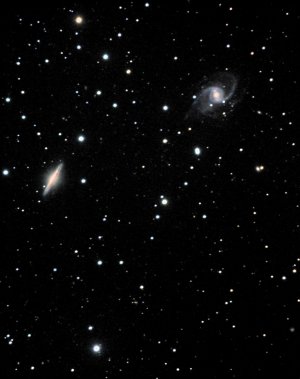
Celestron CG 9 1/4 inch, ST2000XM, 66:24:24:24 This is my fifth and last image from TSP 2016. These are two small but very interesting galaxies. NGC 5905, to the upper right, is very similar to Arp's classification of Integral Sign spirals. There is a lot of "stuff" inside the lower left arm. And, while it is very faint, the arm heading off to the upper right curves back and continues around until it is almost parallel to the lower left arm. Both arms are very knotty, with the knots likely to be star-forming regions. The galaxy toward the left edge of the image, NGC 5908, is a miniature M104. The core seems to be even brighter. Like M104, it exhibits a very dark dust lane. |
|
|
|
|

10-inch Newtonian, ST2000XM, 88:24:24:28 This is an update of an image originally made in 2009. The original only had 40 minutes of luminance and that wasn't quite enough. An additional 48 minutes helped a lot. The original image can be seen on the Replacements page. NGC 2403 is one of the big, bright, far northern galaxies. It is 11' x 18' in size, and 8.4 magnitude. It has strong blue inner arms, and more tenuous yellowish outer arms, but there are a number of bright star-forming regions in the outer arms. They, of course, tend to be very blue. The core is not as yellow as many of the other galaxies seen here and on the Galaxies page. |
|
|
|
|

10-inch Newtonian, ST2000XM, 72:24:24:24 Arp 268 is classified as a Dwarf Irregular. Arp placed it in his "irregular clumps" group. His notes mention resolution of stars but I believe these are bright young clusters or star-forming regions, not stars. There are some interesting loops and chains of stars these objects, particularly on the left (east) side. |
|
|
|
|

10-inch Newtonian, ST2000XM, 84:28:28:28 NGC 3521 is a large, colorful galaxy in Leo. It is a flocculent spiral, with the class SAB(rs)bc. It is also known as the "Galaxy in a Bubble". My image only hints at the bubble structure and the Astronomy Picture of the Day for September 15, 2011 shows it much better: http://apod.nasa.gov/apod/ap110915.html I've included a negative image which also shows more of the bubble but not as much as the APOD image. Like most images in this part of the sky, many background galaxies can be seen, especially in the Full Size and Negative images. |
|
|
|
|

10-inch Newtonian, ST2000XM, 64:24:24:24 NGC 2859 is a barred galaxy with little or no spiral structure. The classification is (R)SB(r)0+. The ring structure is obvious and there the gap inside the outer ring seems devoid of stars or other structure. All the features are very smooth. The small galaxy above and slightly left of 2859 is UGC 5004. Its morphology is listed as Im or Im?, but it seems too organized to be an irregular. |
|
|
|
|
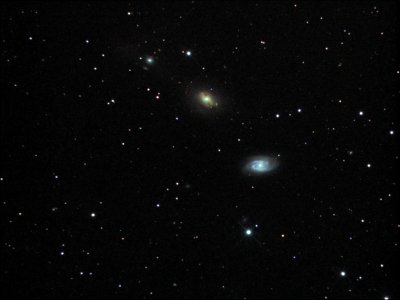
10-inch Newtonian, ST2000XM, 48:16:16:16 The galaxies in this group are small but bright and very interesting. The largest, just right of center, is 2964. Above it, and to the left, is NGC 2968. The smallest of the group. near the top edge, is NGC 2970. The field is littered with smaller galaxies. Inside of 2964, about halfway from the core to the left edge, is the object Markarian 404. There appears to be some debate about what it is, as NED lists it as a galaxy but also describes it as a H II region within 2964. Personally, I would agree with the latter description since it simply looks like a large knot in the arm. The classification for 2964 is SAB(r)bc: To me, it looks like a polar ring galaxy. I also question the classification of 2968, which is listed as either I0 or S0. To me, it looks like an S0:pec similar to NGC 5128, or even an edge-on spiral with a heavy dust lane. In any case, there is a lot to look at and debate. |
|
|
|
|
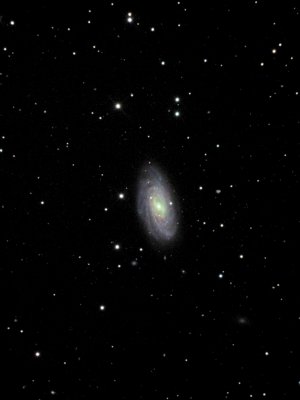
10-inch Newtonian, ST2000XM, 60:20:20:20 It is generally accepted that M109 is NGC 3992 but there are doubters who feel that NGC 3953 is the real M109. See the article http://www.astrobril.nl/FortinOther.html#M109. The two are only 1.2 degrees apart and based on the communication between Mechain and Messier, confusion was certainly possible. Whatever the history, NGC 3953 is an especially beautiful galaxy. It has numerous fine, crisp arms with lots of blue knots, and strong yellow core. The classification is SB(r)bc. The bar is not very prominent. There are several small companions nearby. |
|
|
|
|
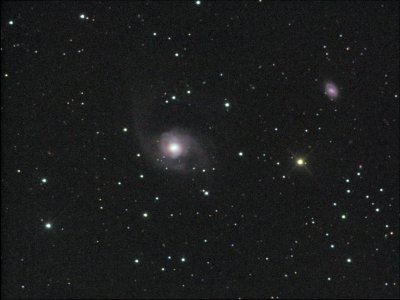
10-inch Newtonian, ST2000XM, 60:28:28:28 Arp 222 (NGC 7727) has four arms, one very long, sweeping west and then north, one of medium length curving south, and two others so short that they hardly appear to be arms. All show very little color and are quite smooth. This galaxy is reported to have a double nucleus but that isn't seen at the resolution of my image. It is believed to be the product of an ancient merger. NGC 7724, toward the upper right, is a peculiar ring-type barred spiral. It is significantly redder than Arp 222. |
|
|
|
|
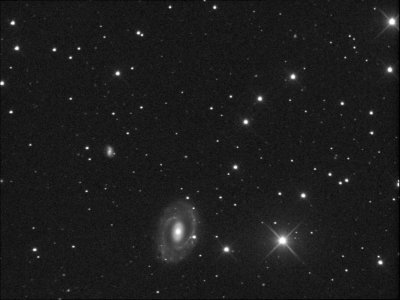
10-inch Newtonian, ST2000XM, 60 min. This is the only time I've put up a monochrome image except for a couple of H-alpha images. During the color exposures, I was experiencing severe and worsening dew. By the time I completed the blue exposures, the only things visible on my screen were the galaxy nucleus and the bright star just to the right. The luminance image was interesting so I decided to show it until I can complete the color exposures, but that won't happen until next year. NGC 210 is a barred spiral with two unusual arms, and some authors believe it is on the way to becoming a ring galaxy. The arms are very knotty and show a lot of detail. The small galaxy above and left is MCG -2-2-82. It is also a barred spiral. |
|
|
|
|
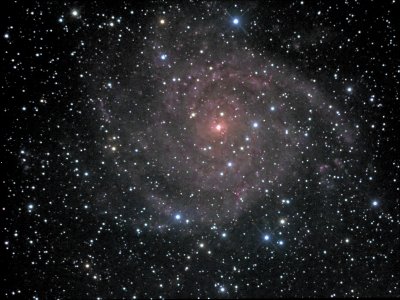
10-inch Newtonian, ST2000XM, 120:32:32:32 IC 342 is a big, beautiful face-on spiral. It is classified as barred, but the bar is not very large or prominent. This galaxy was not discovered until 1895 because the surface brightness is so low. The total magnitude is 9.1 but this is spread out over a diameter greater than 21'. It is the third largest galaxy in apparent diameter, exceeded only by M31 and M33. It would be much brighter if it were not near the plane of the Milky Way and dimmed by its gas and dust. The arms are peppered with bright pink H-alpha regions, best seen in the Full size image. Like NGC 210, above, conditions were very poor during the collection of this image, with a lot of dewing of my optics. I was able to keep it under moderate control with liberal use of a hair drier, but don't have a lot of confidence in my color data, and the contrast is probably less than I should have achieved. |
|
|
|
|
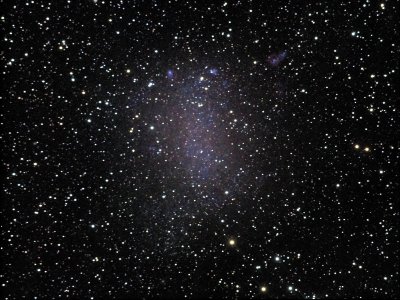
10-inch Newtonian, ST2000XM, 72:24:24:24 NGC 6822, also known as Barnard's Galaxy, is a barred irregular similar to the Small Magellanic Cloud. It is one of the closest galaxies, at approximately 1.6 million light years. It has an apparent size of 13.5' x 15.5' and a visual magnitude of 9.3. It gives the appearance of resolving into thousands of stars but almost all of the apparent stars are really star forming regions, like the Trapezium region in Orion. Because it is nearby, many gaseous nebulae (HII regions) can be seen. It even has its own Bubble and Ring nebulae, located close together off the upper right corner of the galaxy. |
|
|
|
|

10-inch Newtonian, ST2000XM, 84:28:28:28 This is a replacement image; the earlier version can be found on the Replacements page. The previous image had essentially equal exposure and I tried to combine the data. While the combined image had a little less background noise and the Cirrus was a tiny bit more obvious, it did not show nearly as much fine detail. Since 2011 when the previous image was acquired, I've made enough improvement in collimation, focus, and guiding that adding the old data made this image worse. NGC 6951 is a lovely barred spiral, very yellowish in color. But perhaps the most interesting things about this image are the faint dust clouds just visible in the background. These are called galactic cirrus. They are most visible at high galactic latitudes but can be found almost anywhere with a deep enough exposure. The dust is illuminated by the integrated flux of all the stars in the Milky Way, rather than by any particular object. NGC 6951 is a Seyfert 2 galaxy with low surface brightness. |
|
|
|
|
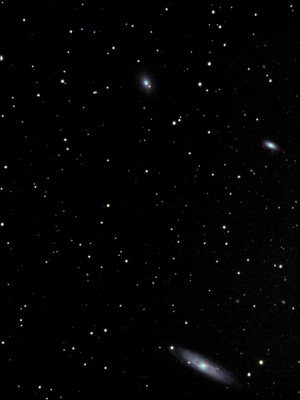
10-inch Newtonian, ST2000XM, 60:20:20:20 NGC 7184 is the larger barred ring-type spiral near the bottom of the field. The smaller galaxy near the top is NGC 7185 and one near the right edge is NGC 7180. With NGC 7188, out of the field at the top left, the four are considered a galaxy group. It is interesting, but probably of no significance, that all four members are spirals and all except 7180 are ring-type. Most groups contain at least one elliptical and ring-type galaxies are not very common. As with almost all images, this one would have benefited from more exposure but the biggest problem was the sky conditions. It was quite clear at the start but had become very hazy by the time I finished. Dew was dripping off the telescope tube. This increased the noise and messed up the color balance. |
|
|
|
|
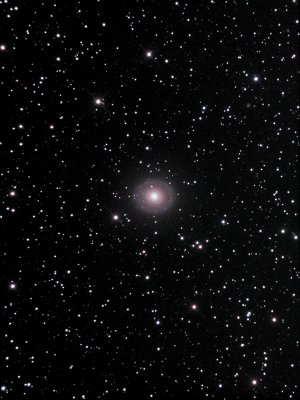
10-inch Newtonian, ST2000XM, 60:20:20:20 NGC 7217 is an unbarred spiral with a large number of rings, some of stars and some of gas. It is officially classified as a ring-type galaxy, (R)SA(r)ab, but this is controversial. One recent reference calls it "unclassified" because of all the unusual characteristics. It contains star populations rotating in opposite directions, for one thing. These peculiar aspects would point toward a history of mergers but, at least today, it appears isolated in space with no other galaxies around. It is a challenge to image because of the huge brightness difference between the central region and the outer arms/rings. If you Google images of it, colors are all over the map. |
|
|
|
|
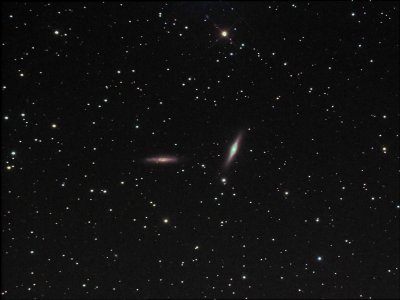
10-inch Newtonian, ST2000XM, 48:16:16:16 NGC 7332 is the S0 pec galaxy on the right while NGC 7339 is the SAB(s)bc:? on the left. 7339 seems more interesting, having a turbulent and somewhat distorted appearance. The pair are not believed to be interacting. 7332 is described as having a boxy or peanut shaped bulge. |
|
|
|
|
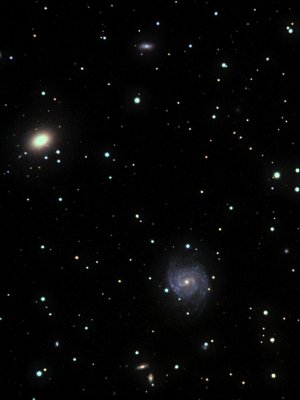
10-inch Newtonian, ST2000XM, 95:30:30:30 NGC 1042 is the face-on spiral toward the lower right corner of the image. The bright elliptical near the left edge is 1052. The spiral near the top is 1047 and the pair near the bottom are NGC 1048 and 1048A. NGC 1042 is a two-armed spiral with lots of knots. It is considered to be a pair with NGC 1035, a much smaller galaxy off the upper right edge of this field. While visually far less interesting, NGC 1052 is of much greater interest to professionals. It is an x-ray and radio emitting galaxy and has two jets detected in radio wavelengths. There is little information available on 1047 except for the normal size, photometric, and red shift data. The 1048 - 1048A pair is more interesting as these two are an AGN pair, where both have an active nucleus. I don't find anything in the literature but certainly assume these two are interacting.
|
|
|
|
|

10-inch Newtonian, ST2000XM, 36:20:20:20 This was an extremely short luminance exposure for a galaxy but it is such a bright object that the results were decent. I tried adding the color data to the luminance but it did not improve anything. NGC 1532 is located at -32 53 declination so it is seldom viewed or imaged by northern observers. Even for me, the low altitude resulted in fatter stars than I usually get and the background and fainter areas are noisier. Several references attribute the long plumes to interaction with the adjacent galaxy NGC 1531 but there also appear to be two faint galaxies near the south end which are essentially incorporated into 1535. I wonder if one or both could be a companion, like some of our Milky Way companions, which has been almost completely disrupted by the interaction. In support of this theory, the most active region of new star formation (visible from our vantage point) is along the edge of the disk closest to these companions. |
|
|
|
|

10-inch Newtonian, ST2000XM, 100:36:36:36 NGC 1365 is a beautiful barred spiral, with a large straight bar and arms beginning at the ends of the bar. It is quite large, being listed at 6.6' x 11.3', and is a member of the Fornax galaxy cluster. This galaxy has everything: it is a Seyfert, has strong X-ray emission, contains a rapidly spinning supermassive black hole at the core, and is undergoing intense starburst activity. |
|
|
|
|
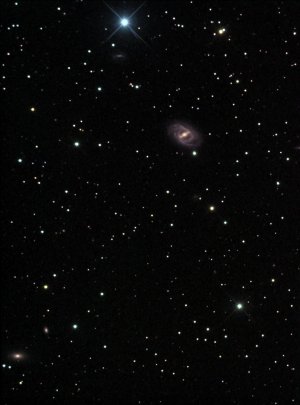
10-inch Newtonian, ST2000XM, 60:28:28:28 Arp 9 is a barred spiral with arms making a complete ring. One of the arms is split. While the star-forming knots are very blue, my image shows the galaxy as a whole to be yellower than most of the images I find in the literature. The first time I saw this result, I decided I must have done something wrong. So, I took another full set of color data, under excellent conditions, and it showed the same result as the first set. It could still be me but I suspect that people have been tweaking their color data to produce what is expected, not necessarily what is real. The little spiral in the lower left corner is NGC 2523C; 2523B is just outside the field due east of 2523 (Arp 9). UGC 4279, a very strange little galaxy, is just below the brightest star at the top of the field. It is listed in NED as class SBdm. The little galaxy about 2.6' NE of 2523C is plotted in Megastar as a "nonstar". It is listed in the 2MASX, GALEX, and LEDA catalogs but not in any of those often used by amateurs. |
|
|
|
|
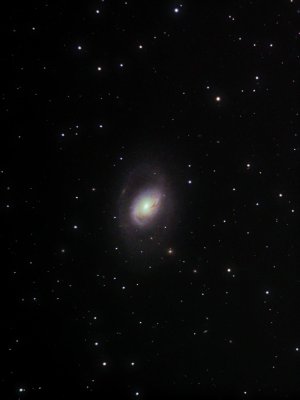
10-inch Newtonian, ST2000XM, 48:16:16:16 M96 is a big, beautiful galaxy in Leo. It is classified as SAB(rs)ab and has been suggested to be a double-barred spiral. However, the bar, or bars, aren't visible at the resolution of my image. It is my understanding the the primary bar is extemely short and the second is questionable. M96 is a heavily researched object, with 675 references listed in NED. The very skinny little object at the edge of the inner halo, at about 10 o'clock, is identified as 2MFGC 08391, but with very little information about it. The single NED reference identifies it as an X-ray point source. |
|
|
|
|

10-inch Newtonian, ST2000XM, 60:20:20:20 IC 1613 is a huge sparkler of a galaxy. It is a member of the Local Group and, using NED data, is about 94% of the distance to the Andromeda Galaxy, M31. However, other sources have M31 closer, and there are at least half a dozen galaxies where the uncertainties in the distances could completely reorder that part of the list. In any case, as galaxies go, it is close. It is a dwarf irregular galaxy, like the Large and Small Magellanic Clouds. What appear to be stars are largely star forming regions or associations. It contains some obvious HII regions, especially in the upper left corner. They would have been much more obvious in exposures through an H-alpha filter. I may try to add this at some future date. The galaxy is offset in the image because I needed to find a sufficiently bright guidestar. |
|
|
|
|
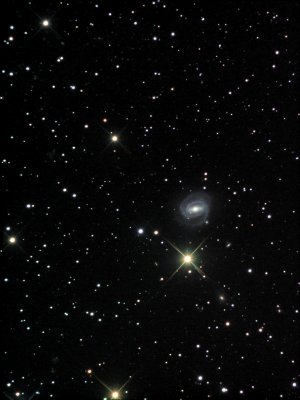
10-inch Newtonian, ST2000XM, 84:28:28:28 NGC 266 is a very beautiful example of a barred spiral. The full size image shows the arms to be full of tiny knots. It is a huge galaxy, appearing small because of it's 214 million LY distance. It has a low-luminosity active nucleus. A 2005 SN has been extensively studied because the progenitor star was not of a class normally expected to produce a SN. |
|
|
|
|
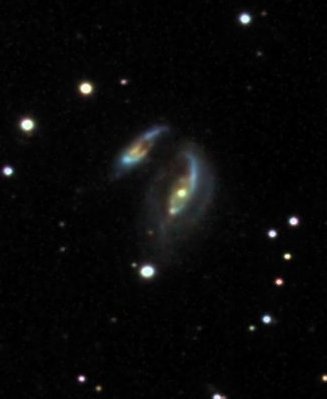 VV 254 (UGC 12914 and 12915) 10-inch Newtonian, ST2000XM, 64:20:20:20 The "thumbnail" here is the only one on the site that is cropped. These galaxies are so small that the normal thumbnail shows very little. I would not want anyone to think there was nothing to see and skip this pair. The VV galaxies make up a catalog published by B.A. Vorontsov-Velyaminov and others, first in 1959 with additions in the 70's and in 2001. The initial catalog showed galaxies thought to be interacting; so were most of the others but some were simply peculiar. Halton Arp included many of the VV objects in his catalog of peculiar galaxies. This was the first non-Arp VV object that I have imaged. My inspiration for making this image was an article by Steve Gottlieb in the September 2014 issue of Sky and Telescope, titled "Seeking Interacting Galaxies". This article has a much more complete history of the VV catalog, and additional examples of the contained objects. This pair is unusually colorful, with lots of reddish-brown dust. The larger member is also cataloged as UGC 12914 and the smaller as UGC 12915. |
|
|
|
|

10-inch Newtonian, ST2000XM, 72:24:24:24 This tightly wound spiral is the brightest galaxy in Aquarius. The listed dimensions are 5.5' x 2.2', with magnitude of 11.5. The arms show a low rate of star formation but this galaxy has not been the subject of much research. |
|
|
|
|
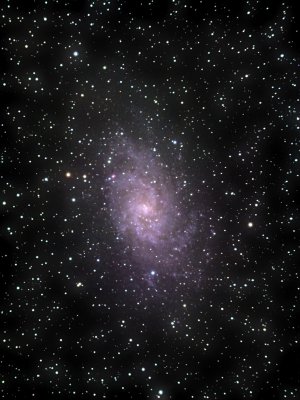
Astro-Tech AT66ED, ST2000XM, 120:40:40:40 minutes, 76' x102' It's M33. What can I say about it that has not been said many times already. The image was done over two nights from my yard in The Woodlands, TX. It would have been better, especially the color, if done at a dark sky site but I was able to deal with the gradients fairly well. |
|
|
|
|
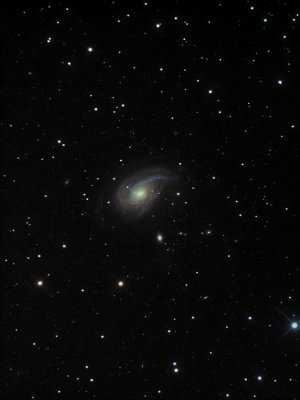
10-inch Newtonian, ST2000XM, 48:16:16:16 The large galaxy is NGC 772, the largest companion (below and slightly right) is NGC 770, and PGC 7509 (just right of 770) is nearly star-like in this thumbnail. PGC 7493 is further to the right but is not considered part of the Arp. While Arp 78 is not really a one-armed galaxy, one arm is certainly dominant. This arm is full of knots and star-forming regions. This almost certainly is a result of earlier interactions between 772, 770, and/or PGC 7509. Faint bulges of material between the end of the heavy arm and both of the companions can just be detected in my larger images, and are easily seen in deeper images taken by others. See the Astronomy Picture of the Day for July 7, 2011. |
|
|
|
|

10-inch Newtonian, ST2000XM, 140:44:44:44 This is a replacement image, and is a combination of data collected in 2010 with new data. The new data is much sharper and the combined image shows more detail, as well as being deeper. The new data was collected by accident as I had failed to remove the finder chart from my binder of planned images. You can see the original image on the Replacements page. NGC 925 is a large, loose barred spiral. The arms are very unsymmetrical and there is obviously a lot of star formation going on. There is an interesting little galaxy nestled among a group of stars just E (left) of NGC 925. Other than a number, 2MASX J02274393+3332286, and a couple of diameters, 5.1" and 6.4", there is no data available on it, but I suspect it might be a companion. |
|
|
|
|
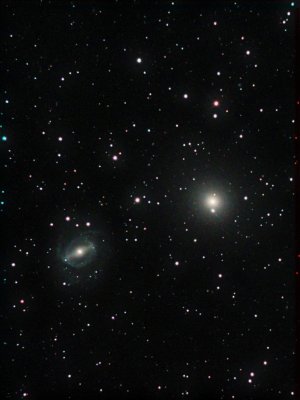
10-inch Newtonian, ST2000XM, 65:20:20:20 NGC 5850 is a ring-type barred spiral while 5846 is an E0-1 elliptical. It is thought that an interaction between the two caused the ring and the unsymmetrical outer arms. However, if the reported distances are correct, the interaction must have been very long ago. The small, bright elliptical just below the core of 5846 is NGC 5846A but these two are not believed to be interacting. |
|
|
|
|

10-inch Newtonian, ST2000XM, 75:20:20:20 NGC 3344 is a weakly barred spiral that also contains rings. NGC 5850 (above) has a much more prominent bar and rings, but lacks the heavy arm structure of 3344. This is a relatively nearby galaxy, at 22.5 million light years. NGC 3344ís outer stars are moving in an unusual manner, and the presence of the bar does entirely account for this. It is possible that NGC 3344 passed close by another galaxy and acquired stars from it, but that is uncertain at this point. |
|
|
|
|
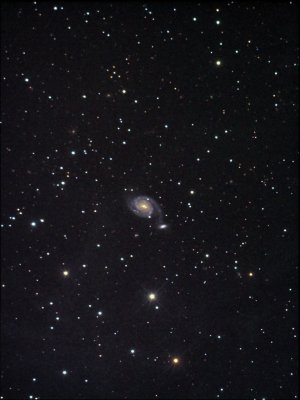
10-inch Newtonian, ST2000XM, 100:30:30:30 NGC 7752, the larger member of the pair, is a barred spiral but the bar is not especially prominent. The companion is classified as an I0, but that has been the subject of some debate. The pair is usually referred to as an M51-type object. An examination of the Full Size image shows a multitude of tiny galaxies nearby. |
|
|
|
|
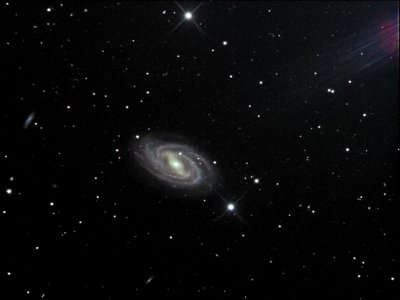
10-inch Newtonian, ST2000XM, 48:16:16:16 M109 is a bright, beautiful barred spiral in Ursa Major. It shows up very well even with only 48 minutes of luminance. In fact, I consider this one of my best images. The flare in the upper right corner of the field is from gamma UMa, located only 19' outside the field. I decided not to try to remove it but just leave it untouched. There are a lot of tiny galaxies in the field but the only ones of any size are UCG 6969 near the left edge and UGC 6940 near the bottom. |
|
|
|
|
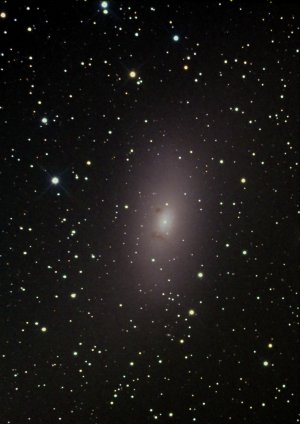
10-inch Newtonian, ST2000XM, 28:20:24:20 M110 is a companion, along with M32, to M31, the Andromeda Galaxy. There are many fainter companions. It was not included in Messier's catalog but was added recently based on sketches by Messier which showed it in the field with M31. It is generally called a elliptical but has several features which make it unusual. The dust clouds and the hint of structure near the core are not typical of ellipticals. It is being slowly consumed by M31, and this can be seen in the trail of material exiting the galaxy heading toward M31, a little over a half degree to the SW (lower left) |
|
|
|
|

10-inch Newtonian, ST2000XM, 60:20:20:20 Arp 210 is a relatively nearby dwarf irregular galaxy, like the Magellenic Clouds. It exhibits a large amount of star formation and numerous supernovae. It is one of the few blue-shifted galaxies, meaning that it is moving toward us. While not a favorite target of amateur astronomers, it is the subject of much professional activity. |
|
|
|
|

10-inch Newtonian, ST2000XM, 60:20:20:20 NGC 2992 is the upper galaxy and 2993 is lower and to the left. For such a complex and interesting system, this object has not been studied very extensively. NED list only 16 references and in many of them it is only an object(s) on a list. The interactions are obvious, with a tidal tail exiting 2993 and a bridge between them. A dusty area can be seen in 2992. The very skinny little galaxy just below and right of Arp 245 is RFCG 1621. |
|
|
|
|
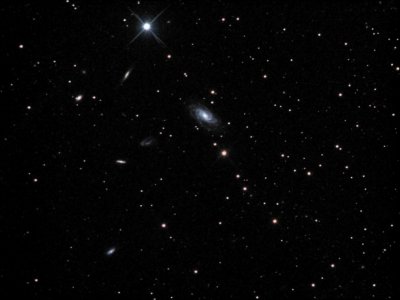
10-inch Newtonian, ST2000XM, 60:20:20:20 NGC 2998 is fairly small and faint but is the dominant
galaxy in a group of smaller companions. The group is somewhat
unusual because all members are spirals; most groups contain at least
one elliptical, often the dominant member. Two of the "missing" NGC objects have listed positions which would place them in the group. These are NGC 3000 and 3004. |
|
|
|
|
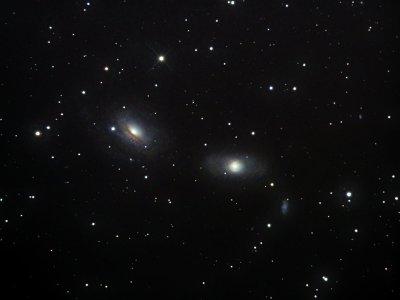
10-inch Newtonian, ST2000XM, 60:20:20:20 Starting from the left, the most interesting and unusual galaxy is NGC 3169. It is classified as SA(s)a pec. It has an asymmetrical spiral arm and, to me, looks like a whirlpool. It also has a very dense dust lane. It has been the home of a couple of recent supernova. NGC 3166, a spiral with tightly wound arms, is in the center. NGC 3166 and 69 are described as being in a death spiral. They will eventually merge and are being pulled apart as they approach each other. The smallest galaxy, NGC 3165 , is on the right. |
|
|
|
|
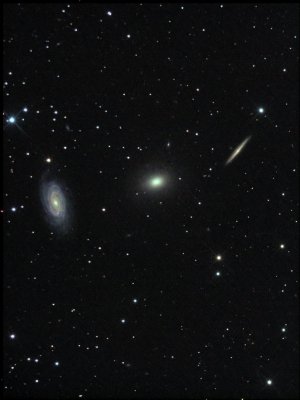
10-inch Newtonian, ST2000XM, 84:28:28:28 This attractive group is also known as the Draco Trio. NGC 5985 is the large, almost face-on spiral on the left. The elliptical in the center is NGC 5982. The edge-on spiral on the right is NGC 5981. It shows a dust lane which is slightly off center from our viewing position. These are fairly bright galaxies and the contrast in shapes makes it an attractive target for visual observers as well as imagers. |
|
|
|
|
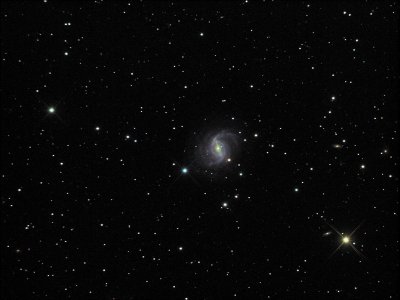
10-inch Newtonian, ST2000XM, 60:20:20:20 NGC 5921 is a barred spiral in the constellation Serpens. One supernova has been found within its boundaries. The bar is very prominent and the arms start at the ends. The northern arm is especially knotty. |
|
|
|
|
 10-inch Newtonian, ST2000XM, 90:30:30:30 These galaxies were more of a processing challenge than a imaging challenge. Just 2' outside the bottom of the field is a 6.44 magnitude star. You can see two of the diffraction spikes but, more importantly, the blooming trail even with my anti-blooming camera. Reflections from the star filled the field with light streaks. I had to work hard to minimize them and use very mild scaling to keep them from dominating the image. As a result, much of the fainter data can't be seen. The larger galaxy near the top of the field is UGC 12350. To its left, near the edge, is CGCG 453-69. The most interesting galaxy is UGC 12342 near the bottom. It looks very birdlike to me, and I've named it the Seagull Galaxy. My image is not as clear as I would like but it looks like this object is actually two galaxies in merger, like a tiny Antennae. It is listed by Vorontsov-Velyaminov in their catalog of possibly interacting galaxies as VV 738. |
|
|
|
|
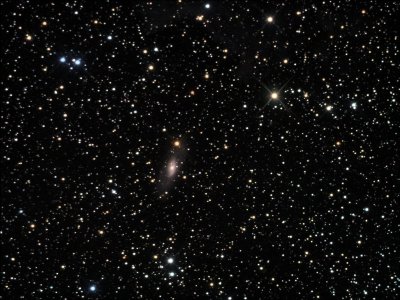
10-inch Newtonian, ST2000XM, 60:20:20:20 NGC 7013 is frequently cataloged as a ring galaxy but this seems to be somewhat uncertain. A quick scan of the references in NED indicates that it has been given a variety of classifications. An inspection of the full size image certainly makes the ring classification seem reasonable. The inner region is very Saturn-like in appearance. |
|
|
|
|
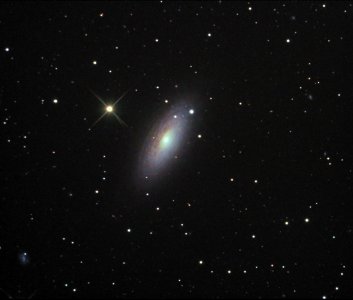
10-inch Newtonian, ST2000XM, 60:20:20:20, 21.7' x 25.5' NGC 2841 is a spiral A type galaxy with tightly wound arms and no bar. It has been called a flocculent type, as the arms are very patchy. It is quite large, 150,000 LY in diameter, about half again as large as our Milky Way. It is about 46 million LY away. It has a low rate of star formation compared to other spirals. The reddish brown color of the arms on the left (east) side indicates to me that we are looking through dust at the stars behind but I haven't found any literature to support that. It is a very popular subject for research, with NED listing 737 references. I have not even read all the titles, let alone looked at the abstracts, so some studies could easily exist. The little spiral in the lower left corner is CGCG 265-9. |
|
|
|
|

10-inch Newtonian, ST2000XM, 104:28:28:28 NGC 3184 is a classic beauty, with near perfect form and an attractive mix of colors. It has been the home of at least 4 recent supernovae, one in 2007, two in 2008, and one in May of 2010, which can be seen at http://en.wikipedia.org/wiki/NGC_3184. It contains two other NGC objects, 3180 and 3181, both of which are HII regions within NGC 3184. Because I made no H-alpha exposures for this image, they are barely detectable and not impressive. |
|
|
|
|
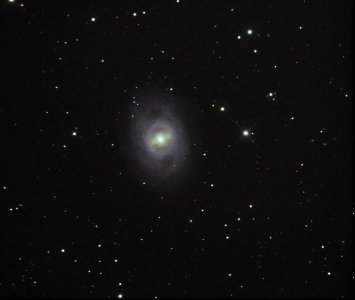
10-inch Newtonian, ST2000XM, 60:20:20:20, 21.7' x 25.6' M95 is a beautiful barred spiral. The classification is SB(R)b, which indicates a barred spiral with a ring, and it certainly fits that description. It was discovered by Mechain in 1781 and first seen by Messier four days later. It is one of the faintest Messier objects but still shows up well in relatively short exposures. M96 is less than a degree away. Only one supernova has been observed in M95 and that was in 2012. |
|
|
|
|

10-inch Newtonian, ST2000XM, 60:20:20:20, 21.7' x 25.6' NGC 4490 is the larger galaxy below center and NGC 4485 is the smaller one above it. Together, they make up Arp 269. Some references give 4490 the common name "Cocoon Galaxy" but that name appears to be applied to a number of galaxies. NGC 4490 is a very colorful galaxy, covering about as wide a color range as galaxies exhibit. NGC 4485 is mostly blue. In this image, the bridge between the galaxies and the tail exiting 4490 to the left are both extremely faint, barely detectable in the larger images. While most of the features show up well in this two hour image, those would have benefited from longer exposure. You will notice that my stars are slightly elliptical; the camera was tilted slightly in the focuser and I did not notice it until I was well into my imaging. |
|
|
|
|

10-inch Newtonian, ST2000XM, 84:28:28:28 NGC 2366 and its companion NGC 2363 are both Irregular galaxies. NGC 2366 is very blue and 2363 is only slightly less blue. 2363 has a lot of h-alpha emission giving it a slightly pink cast. This pair would be interesting with the addition of the h-alpha data. It is a small galaxy, about the same size as our companion galaxies (the Large and Small Magellanic Clouds), and is a member of the M81 group. It is full of knots and star forming regions. In very large telescopes, individual stars can be resolved but the small bright spots in this image are large clusters of stars. |
|
|
|
|
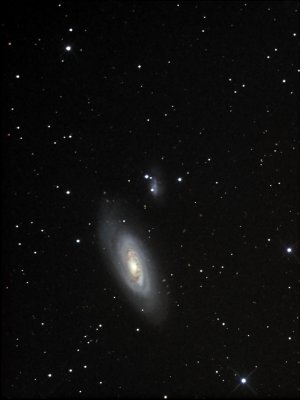
10-inch Newtonian, ST2000XM, 48:16:16:16 M90 is one of the Virgo Cluster of galaxies, and is one of the largest and brightest of the spirals. While it is, in general, a fairly quiet galaxy, there have been several bursts of star formation in the inner regions within the last 5-30 million years. That is very recent in cosmological terms. It is one of the few galaxies outside the Local Group that exhibits a blue shift, meaning that it is approaching, rather than receding, from our galaxy. Arp classifies it as "spiral with small HSB companion on arm". That companion is IC 3583, almost in the exact center of the field. See "The Arp Atlas of Peculiar Galaxies" by Kanipe and Webb for a discussion of the controversy about whether the two have undergone an interaction. M90 consists only of NGC 4569; IC 3583 was unknown to Messier.
|
|
|
|
|

10-inch Newtonian, ST2000XM, 72:24:24:24 Arp classified 213 as "irregularities, absorption, and resolution". While the spiral structure is difficult to see in this thumbnail image, and visible but not prominent in the Full Size image, it shows as a very tightly wound spiral in high resolution images from large telescopes. The most unusual aspect is the absorption feature running from the core to the halo. It is an unbroken band cutting across all of the spiral arms with no apparent mutual effect. The galaxy color is typical of old galaxies, with no star formation evident. The larger and brighter of the two skinny, edge-on galaxies in the lower left corner is UGC 2955. The very skinny one further to the left is 2MFGC 03399. |
|
|
|
|
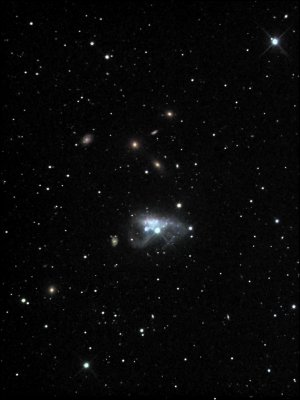
10-inch Newtonian, ST2000XM, 60:20:20:20 Arp 263 is weird even among Arp's peculiar galaxies. I don't know of another one that is similar. Dr. Arp put it in his "irregular clumps" class; the standard classification is IB(s)m pec. While there are some nearby galaxies, I see no evidence of interaction. A 1990 study concluded that it is the product of two galaxies merging. It is extremely blue, meaning that most of the stars are young. There are many small galaxies in the field. The one just off the lower left corner of Arp 263 is CGCG 94-42. Further down and left is CGCG 94-46. Directly above Arp 263 is CGCG 94-40, up and left from that is MCG +3-27-26, and left from there is UGC 5639. Returning to MCG +3-27-26 and heading up and to the right we find first CGCG 94-43 and finally MCG +3-27-23. Well over 100 galaxies can be found in the image. |
|
|
|
|
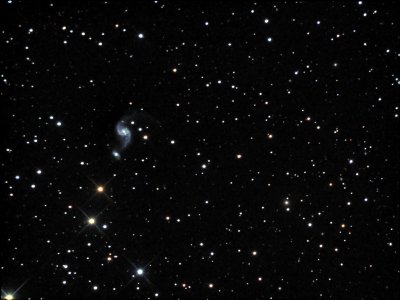
10-inch Newtonian, ST2000XM, 80:20:20:20 Arp 82 is a tiny but very interesting pair. The larger member is NGC 2535 and the smaller is 2536. NGC 2535 contain a host of very bright, compact knots and sports a tail, curving north and west, which is longer than the parent galaxy. It is also very knotty but the knots are fainter and more diffuse than those in the main body. NGC 2536 has two broad sweeping arms exiting the core in opposite directions. There is a faint bridge connecting the two galaxies. The bright compact galaxy about 13' WSW of the core of 2535 is a 2MASX galaxy. Even though the field is packed with tiny galaxies, none of them are named in any common catalogs. |
|
|
|
|
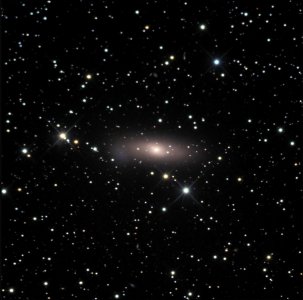
10-inch Newtonian, ST2000XM, 130:20:20:20 This images replaces one done a couple of years ago. That image can be found on the Replacements page. NGC 1023 is the large yellow galaxy in the center of the field. It is classified as SB(rs)0- but the bar is not very obvious in this image. It is slightly easier to see (or imagine?) in a shorter exposure. NGC 1023A is the small bluish galaxy at the E (left) end of 1023. It is classified as IB?. Together, they make up Arp 135. There is another small galaxy, PGC 10169, hiding in the glare of the bright star to the left of Arp 135, and some tiny background galaxies or dwarf companions throughout the field. NGC 1023A is much easier to see in this color image than it is in monochrome images, because of the color contrast. NGC 1023A is more granular, or knotty, than 1023, which has a very smooth texture -- compare them on the full size image. 1023A also has some small and indistinct absorption and emission features. |
|
|
|
|

10-inch Newtonian, ST2000XM, 48:24:24:24 The larger spiral just above center is Arp 14. The tiny galaxy below and right of Arp 14 (just right of the center of the field) is NGC 7313. The faint, strangely shaped galaxy just above the bright star in the lower left corner is ESO 534-1. Arp 14 has two unusual features at the north (upper) end, one large and very blue and one smaller and very red. It has a chaotic arm structure. The luminance exposure was less than planned because I lost it in the trees. |
|
|
|
|
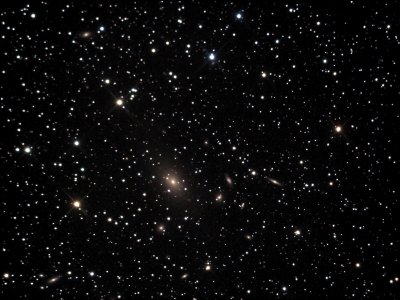
10-inch Newtonian, ST2000XM, 48:20:20:20 The large elliptical galaxy just below and left of center is NGC 7242. The only other NGC galaxy in the field is bright but tiny NGC 7240, 3.6' right and slightly down (WSW) from 7242. Above and continuing slightly W from 7240 is IC 1441, and the skinny galaxy still further W is IC 5191. Almost directly below NGC 7242 is IC 5193 and in the lower left corner is CGCG 514-4. Near the top of the field, about halfway left of center, is MCG +6-49-1. This field is packed with galaxies, several almost as bright as those identified. I can count at least 15 just within, or barely beyond, the halo of 7242. I stopped this exposure before I had planned, because it simply didn't look like there was very much of interest in the field. Now I wish I had exposed longer, just to see how many galaxies I could find. |
|
|
|
|
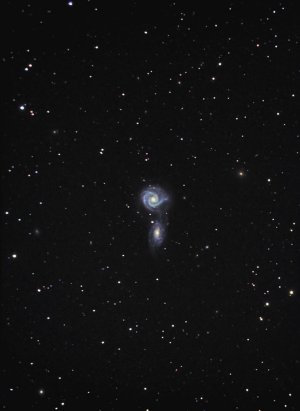
10-inch Newtonian, ST2000XM, 104:36:32:40 This image is another "accident", like M83 below. I did not realize I had imaged it a year ago; really do need to clean up my records. However, like M83, the new image is much better and is better than a combination of the new and old. The old image can be seen on the Replacements page. Arp 271 will always be special to me because it was the last image to complete my collection of all 338. It is a beautiful one, and was a nice way to finish. This color version and the previous one are much deeper than the earlier monochrome. The upper galaxy is NGC 5427 and the lower is 5426. The interaction appears to have disturbed 5426 more than 5427, as it has a host of star-forming knots, but neither has been extremely distorted. The eastern arm of 5427 is forked (bifurcated) and sweeps down into 5426 (or vice versa). It is possible that our Milky Way and the Andromeda Galaxy will have a similar interaction in a few million years. There is some confusion in Megastar as the upper galaxy is identified as 5428 but NED confirms the identification used here. There are many tiny galaxies in this field. Two of the brightest are LCRS B140121.0-054945, directly left of NGC 5426 a couple minutes inside the edge of the field, and LCRS B140024.4-054536, not quite 7' right of NGC 5427. LCRS stands for Las Campanas Red Shift Survey. |
|
|
|
|
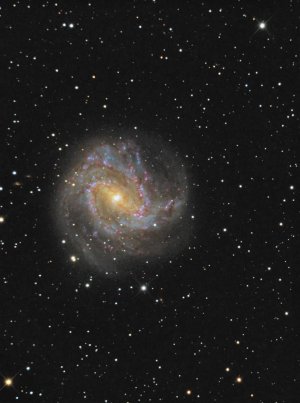
10-inch Newtonian, ST2000XM, 60:20:20:20 This image was actually a mistake. I had imaged M83 two years earlier and didn't remove the chart from my binder of targets. However, this image is so much better that adding the previous data degraded it, and this is all new data. The old image can be seen on the Replacements page. I think the color is much better on this one, especially after it was reprocessed by Al Kelly. Thanks, Al! M83 is certainly one of the most beautiful Messier objects. It is hard to imagine a more "perfect" galaxy. The vicinity of core is filled with older yellow stars, the arms are heavily populated with younger blue stars, but with a good bit of dust and old stars mixed in, and scattered around are a host of pinkish H-alpha regions. The bar is obvious, and the arms are heavy and complex. At slightly under 15 million light years away, it is one of our closest galactic neighbors. The larger of the two tiny galaxies just beyond the left edge of M83 is ESO 444-85. The other is PRC C-47 which, according to the literature, is a polar ring galaxy. I can't began to see that in my image.
|
|
|
|
|

10-inch Newtonian, ST2000XM, 60:20:20:20 NGC 5746 is the edge-on galaxy toward the top of the image. The very blue spiral near the bottom right corner is NGC 5740. NGC 5746, while fairly large and bright, is no match for NGC 4565 below. It has none of the intricate detail seen in 4565. I find NGC 5740 more interesting. It is exceptionally blue, has several delicate outer arms, one of which appears to be forked, and has either a dusty arm or a gap between arms above (north of) the core. The two are considered a non-interacting pair, meaning they are associated and linked by gravity but have not had a close enough approach to produce any mutual distortion. Directly above the brightest star near the center of the field, and right of the lower tip of NGC 5746, is the bluest star that I can remember seeing in any of my images. Conditions were terrible when I was acquiring this image. The sky was hazy, at about 3 mag, and there was a constant 10 - 15 mph wind, with gusts to 25 mph.
|
|
|
|
|
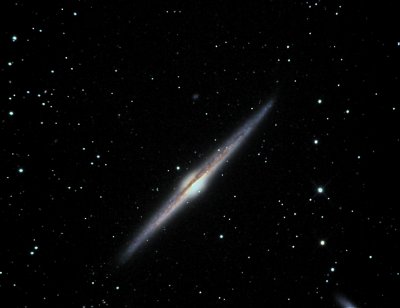
10-inch Newtonian, ST2000XM, 60:20:20:20 This was my first image after having my optics recoated. There is a noticeable improvement in the depth of the images I'm now getting. NGC 4565 is a beautiful object, imaged by many people. It is big and bright, making it a favorite target. It is often called the Needle galaxy. Because of the edge-on view, the classification is uncertain but it is generally believed to be a barred spiral. It is a Seyfert galaxy, meaning it has an active nucleus. An amazing amount of detail is visible in this galaxy, with a multitude of tiny blue knots, a complex and turbulent structure in the dust lane, and a host of tiny galaxies just outside the primary. While some may be background galaxies, the proximity of so many makes me think most must be companions. The little blue irregular galaxy directly above the core of 4565 is IC 3571. The tip of a galaxy peeking into the lower right corner belongs to NGC 4562. |
|
|
|
|
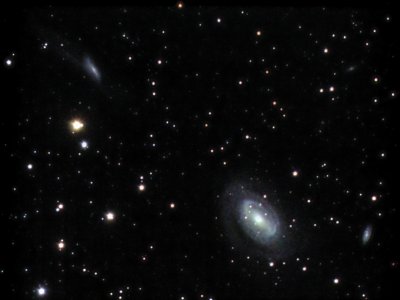
Meade 2045D @ f/10, ST2000XM, 180:48:48:48, 30.4' x 41' This was my first image from the Texas Star Party 2012. The largest galaxy is NGC 4725. NGC 4712 is the small galaxy near the lower right edge of the field. For me, the most interesting galaxy is NGC 4747, near the upper left corner. It is a very blue, somewhat twisted spiral, with a large loop or jet extending out toward the corner of the field for a distance almost twice the length of the main part of the galaxy. Radio telescope observations in the neutral hydrogen wavelength indicate that 4747 and 4725 are interacting. I'm not aware of any visible light images which show an interaction, but something is obviously perturbing 4747. |
|
|
|
|
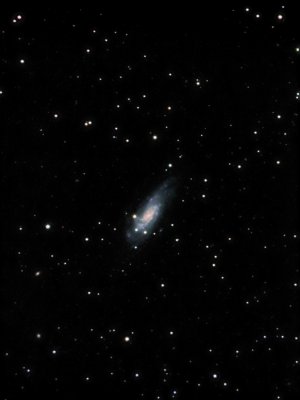
Meade 2045D @ f/10, ST2000XM, 144:48:48:48, 41' x 30.4' NGC 4559 has many blue star forming regions, and is believed to be the home of an intermediate mass black hole, This area of the sky (Coma) is packed with tiny background galaxies. Megastar and some other sources list the classification as SAB(rs)cd but there appears to be a lot of disagreement about this, with some sources no more specific than "spiral". It would look much more impressive if imaged with my 10-inch, but I was looking for targets at TSP that were large enough for the Meade, and that I had not already imaged. IC 3592 is located below the south end of NGC 4559 and several minutes from the left edge of the field. IC 3593 is about 7' directly below 3592. Just over 2' below and right of the NGC 4559 core is IC 3550. NED classifies it as a HII region associated with 4559. If so, it is exceptionally distant and separated from the parent galaxy. And it is incorrectly identified in Megastar as IC 4550. |
|
|
|
|
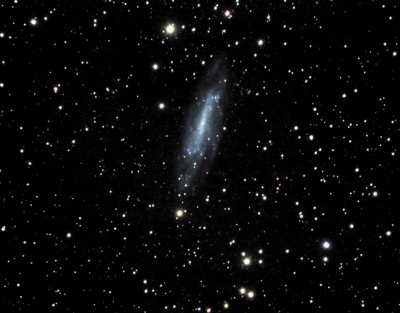
Meade 2045D @ f/6.3, ST2000XM, 228:64:64:64, 30.4' x 41' NGC 4236 was the last of my 2012 Texas Star Party images. And I had forgotten that it was my only 2010 TSP image. However, this one is significantly better so I am moving the old one to the Replacements page. NGC 4236 is a huge galaxy, 22' x 7.2', with a magnitude of 10.1, and has a very low surface brightness. In three different catalogs, the S.B. is listed as 15.0, 16.0, and 23.5 mag./sq. arc sec. The last one is obviously an error, but it is dim. It is a barred spiral and has some interesting features, especially the bright blue "hook" just above and to the left of the core.
|
|
|
|
|
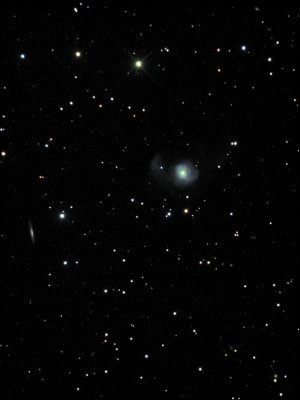
10-inch Newtonian, ST2000XM, 72:24:24:24 Arp 215 is in Arp's group Adjacent Loops, and is classified as SAB(rs)a pec. The large looping arm west of the core is obvious. Just above the noise level, a very faint arm exits opposite the brighter arm and forks, with a short section heading north and a much longer section curving out to just past the bright double star. The central part of the galaxy shows some soft billowy loops and bright blue star-forming regions. The skinny edge-on galaxy on the left side of the field is UGC 4872. |
|
|
|
|
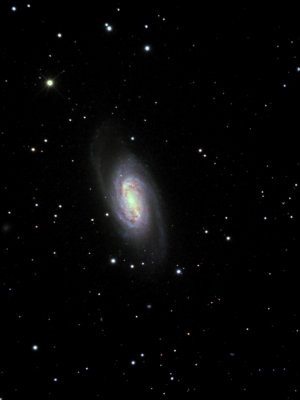
10-inch Newtonian, ST2000XM, 48:20:20:20 This is one big, beautiful galaxy. It is hard to see how Messier could have missed it for his catalog. It is larger and brighter than most of the M-galaxies; compare it to M91 and 108 below. It's a barred spiral and believed to be similar to our own Milky Way. The deep red-brown patches scattered throughout the central part indicate some thick dust clouds. This galaxy contains some very bright young globular clusters; the globulars in our galaxy are all old. The core is very bright. At the far left edge of the field is UGC 5086. It is classified as an Irregular although some researchers identify it as a dwarf elliptical. |
|
|
|
|
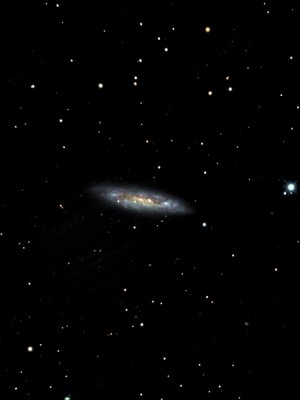
10-inch Newtonian, ST2000XM, 60:20:20:20 M108 is an unusually knotty barred spiral. The classification is SB(s)cd sp. It is quite colorful, with a bright yellow central region and bright blue outside that area. The core is not very bright, especially compared to NGC 2903 above. It was discovered by Pierre Mechain, not by Messier himself. The background is blackened a lot more than I like, to get rid of reflections from beta UMa, located about 1.5 degrees to the northeast. Fortunately, M108 has a sharper than average drop-off of brightness at the edges so I didn't sacrifice much. |
|
|
|
|

10-inch Newtonian, ST2000XM, 60:20:20:20 M91 is a classic barred spiral. It has two delicate arms, dotted with star-forming regions. All of this is contained in a fairly smooth disk like a rich galactic halo. The field is full of small galaxies, including one that appears to show through the halo. Messier discovered M91 on March 18, 1781 but made a mistake in recording the position, and it was long listed as a "missing" Messier. It was not until 1969 that an amateur astronomer, William C. Williams, recognized that NGC 4548 was M91. Messier had described the position in terms of offsets from M58 when he was actually using M89 as his starting point. Applying the offsets properly to M89 puts the position almost precisely on NGC 4548. The only other galaxies listed in the older catalogs are CGCG 99-97, located about 6.5' SW of M91, and VCC 1656, right on the west edge of the field about 25% of the way down from the top. VCC 1656 is classified as an Irregular. To me, it looks like it consists of three interacting or companion galaxies. |
|
|
|
|
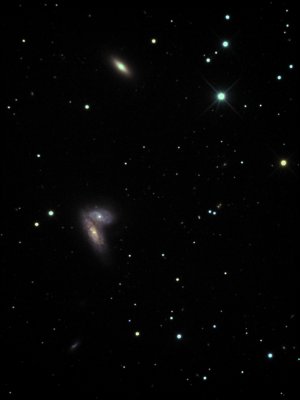
10-inch Newtonian, ST2000XM, 72:24:24:24 NGC 4567 is the upper member of the pair and NGC 4568 is the lower, and larger, member. Near the top of the field is another NGC object, 4564. Just as it is surprising that Messier missed NGC 2903, it is surprising that Dr. Arp did not include this pair in his catalog. If they are not yet interacting, and neither shows a lot of obvious distortion, they are almost certainly headed for it. There has been a fair amount of research into this question, and the current score seems to be about 2 to 1 in favor of interaction already taking place. Go to the NED site for 4568 and read the Notes. The most striking aspect of their appearance is the dramatic color difference. In addition to the three NGC galaxies, IC 3578 is bright and obvious just over 8' south of 4568, and about 3' back toward 4568 on a line between these two is extremely faint VCC 1681. |
|
|
|
|
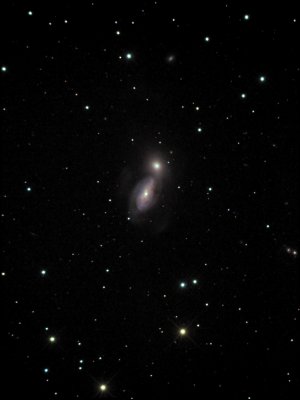
10-inch Newtonian, ST2000XM, 40:24:24:24 The larger galaxy is NGC 3227 and the companion is NGC 3226. The pair is nearly surrounded by faint loops, although these are extremely faint at the south end. This could be gas but I think it is probably a halo of stars thrown out of the galaxies by their interaction. Notice the dark brown, almost black, area slightly above and right of the NGC 3227 core. This in normally indicative of thick dust. There is a pair of apparently interacting galaxies at the right edge of the field, just below Arp 94. This is CGCG 94-22 and is classified as a galactic pair. There are a number of other small galaxies found only in the 2MASX or SDSS catalogs, without any particularly interesting information. For me, the most interesting object other than Arp 94 itself is the intensely blue object (star?) at the top edge of the field, directly above 94. I don't think I've ever captured anything this blue. I only shot 40 minutes of luminosity because I already had an equal amount which I shot in 2008. However, the new data was so much better that the final image would have been degraded by including the old data. Fortunately, this is a fairly bright object so it shows fairly well even with the short exposure. |
|
|
|
|
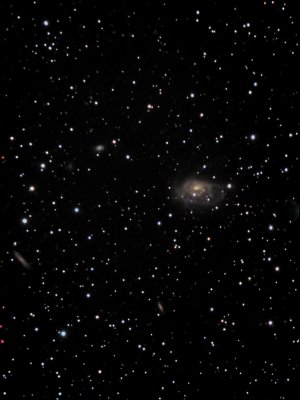
10-inch Newtonian, ST2000XM, 72:24:24:24 Arp 184 could easily be called "The Ear". Notice the wispy tendrils sweeping off to the north (top) side of the galaxy. These are likely the result of an interaction but the other galaxy is not apparent. It could have been largely absorbed and now shows only as one of the "lumps" in 184, or it could be on the opposite side from our viewpoint. The color is surprisingly yellow if it has, in fact, undergone a recent interaction. This field is full of background galaxies. Three of the brightest are UGC 3342, at the left edge, CGCG 329-9, about halfway to the bottom of the field from Arp 184, and CGCG 329-11, a little above and halfway to the left edge from 184. Also, there is a little Irregular just over 2' left and down from CGCG 329-11. |
|
|
|
|
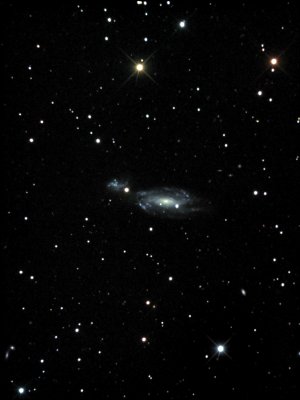
10-inch Newtonian, ST2000XM, 80:28:28:28 Since I've started naming objects, I'll call Arp 279 the "Crab Galaxy". I think it looks more like a crab than the far better known Crab Nebula. The primary galaxy is NGC 1253 and the secondary is 1253A. The secondary is a particularly unusual object. There is another apparently interacting pair right at the left edge near the bottom of the field. As near as I can tell, the lower member is cataloged as KUG 0312-31, while the upper member is a 2MASX object.
|
|
|
|
|

10-inch Newtonian, ST2000XM, 72:24:24:24 NGC 672 is the brighter galaxy closer to the center and IC 1727 is in the lower right part of the field. They are offset so I could find an adequately bright guide star. Both show a lot of interesting structure. While there is some debate about whether they are interacting, I believe that the majority opinion is that they are. Both are very blue, especially IC 1727, and show a very granular texture. NGC 672 is class SB(s)cd and IC 1727 is SB(s)m. The little edge-on galaxy near the center bottom of the field is 2MFGC 012344. The pair of tiny galaxies just barely inside the edge of the field, above and left of NGC 672, is CGCG 482-17. They are cataloged as a galactic pair, with a single designation, the southernmost being NED01 and the more northerly NED02. |
|
|
|
|
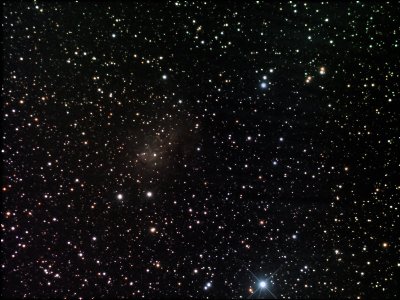
10-inch Newtonian, ST2000XM, 80:24:24:24 IC 10 is an irregular galaxy, similar to the Magellenic Clouds, and is believed to be another member of the local group. It has been extensively studied and has a number of unusual properties. See http://en.wikipedia.org/wiki/IC_10 for some of the data collected on this galaxy. I have not imaged an Irregular galaxy since I was doing my Arp images. IC 10 has an extremely low surface brightness, which adds a special challenge. Also, you can detect some faint streaks on the right side of the image which are reflections from beta Cassiopeia, 1.4 degrees away. |
|
|
|
|
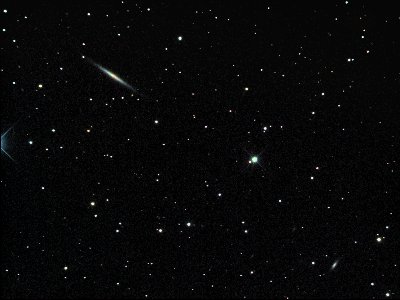
10-inch Newtonian, ST2000XM, 60:20:20:20 This is not a particularly striking image. NGC 100 is small (6.2' x 0.6") and faint (13.9 magnitude). Even though this is technically as good as my images get, with 3.0 arc sec. FWHM stars, not a lot can be seen. There is some lumpiness visible at both ends of the galaxy and the core shows a range of colors, but that's about it. Images taken with much larger scopes and longer focal lengths do show additional detail. One thing that is obvious even in this image is the absence of the dust lane often visible in edge-on galaxies. UGC 219, in the lower right corner, shows a little spiral structure. |
|
|
|
|
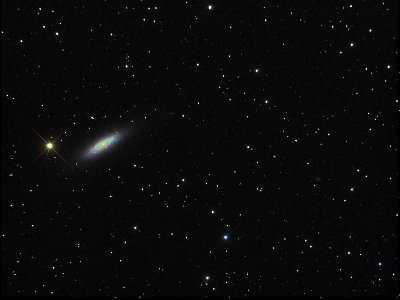
10-inch Newtonian, ST2000XM, 60:20:20:20 NGC 6503 is nice to image as it is fairly bright (10.9 mag.) and has surface brightness of 12.2 mag./sq. arc sec. While longer exposures will certainly show more, it displays well with just one hour of luminance. The Full Size image shows it best. The many knots look like towering thunderstorms, or even the recent Phoenix dust storm. It is full of texture, with the appearance of curdled milk, and quite complex. It has been studied extensively -- NED contains 369 references. It is classified as SA(s)cd, but a Hubble study in 2010 turned up evidence that the apparent core is a strong end-on bar. If that is eventually accepted, the classification will change. |
|
|
|
|

10-inch Newtonian, ST2000XM, 48:18:18:18 M98 is viewed at a low angle but not quite edge-on. It has a complex structure, with a large yellow central portion, bluer arms that are not prominent but have many small knotty star-forming regions, lots of dust in large patches and lanes, and a large yellowish halo which, to me, seems to not be fully aligned with the rest of the galactic disk. It is one of the faintest Messier objects. M98 is classified as SAB(s)ab. It is one of the few blue-shifted galaxies, meaning that it is approaching us instead of receding. Other interesting galaxies in the field include NGC 4186, a tightly-wound spiral about 11.5' SSE of M98, and UGC 7223, a low surface brightness, face-one spiral about the same distance from M98 but more toward the right edge of the field. Almost all of Abell Galaxy Cluster 1499 is covered by the lower left quarter of the field. Abell clusters are typically large clusters of faint galaxies. Megastar reports that 1499 includes 58 galaxies, 48 of which are 16.6 magnitude or fainter. |
|
|
|
|

10-inch Newtonian, ST2000XM, 60:21:21:21 M99 is a classically beautiful face-on spiral, as indicated by its classification SA(s)c. It is rather asymmetric, with the core off center and one arm much heavier and less tightly wound than the others. The arms are full of blue star-forming regions, but the knots in the arm that starts on the W (right) side and swings almost horizontally over the core seem to me to show a pink cast. That would indicate that there is a significant amount of hydrogen alpha nebulosity in these knots. There have been at least three supernovae observed in this galaxy. There is a neat little barred spiral just right of the bright star. |
|
|
|
|
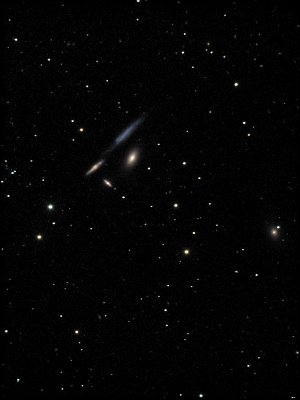
10-inch Newtonian, ST2000XM, 90:30:30:30 The NGC 4169 group is also known as The Box. NGC 4169 itself is the S0 spiral in the middle right of the group. By far the most interesting galaxy is NGC 4170, the long, skinny blue galaxy at the top of the Box. It is classified as an SBd but I cannot see any evidence of a bar because of the nearly edge-on viewing angle. The color is very different from the other galaxies and probably represents a burst of new star formation as a result of an interaction with one of them. The best candidate is NGC 4175, in the lower left corner of the Box. It shows an unusual lump or knot, almost like a second core, toward the end nearest 4170. Finally, the galaxy at the bottom of the box is NGC 4174. It looks fairly normal except for the large and prominent core. The disk of NGC 4170, which we are seeing almost edge-on, is warped into a very flat S shape. This and the lump in NGC 4175 are best seen in the Monochrome negative image. It points out how images in different wavelengths can provide different information. These details are best seen in monochrome but that image gives no hint of the dramatic color differences. An infrared or X-ray image would probably show something very different than these visible light images. The galaxy near the right edge of the field is UGC 7190. A small slice of Abell Galaxy Cluster 1495 can be seen along the middle part of the left edge of the field. There are host of tiny galaxies in that area. The whole cluster includes 123 galaxies but we can see only about 25 of them in the field. |
|
|
|
|
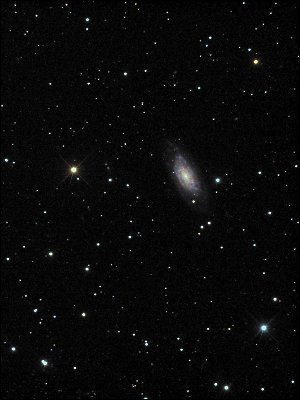
10-inch Newtonian, ST2000XM, 90:30:30:30 This is a pretty galaxy that appears to be a popular target for imaging. A Google search turns up about three full pages of images of this galaxy, although some are repeats. It shows a yellow core region, with no bar, prominent dust lanes, knotty blue arms, and a large, faint yellowish halo. There is a large faint glow approximately 1.8' SE of the core, which I'm guessing is the remains of a satellite galaxy. I've been unable to match it with anything in NED. Maybe someone else will have better luck. |
|
|
|
|
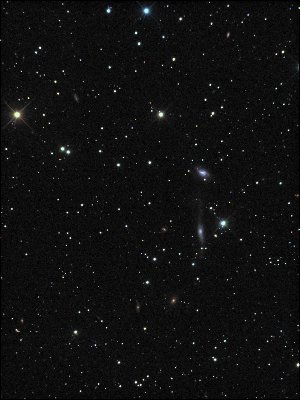 Arp 254 (NGC 5917 and MCG-1-39-3) 10-inch Newtonian, ST2000XM, 90:30:30:30 This is an image that only an Arp enthusiast could enjoy. Things are very small and very faint. It appears fairly certain that there has been a collision or close approach. NGC 5917, the upper member of the pair, has been suggested as one of the colliding galaxies. It seems somewhat distorted but not dramatically so. It is generally symmetrical around the core except for one arm, or structure, that cuts across the primary arms. It is classified Sb pec?. MCG-1-39-3 is the strange one. At first glance, it looks like we are seeing it edge-on but I believe it is simply so stretched out that it looks like an edge-on. It has a tail pointing S (down) and another one pointing N (up) toward NGC 5917. In the Monochrome link below, you may be able to detect some slight granularity near the middle of the N tail, and a faint hook at the end. However, I don't see the N tail quite reaching NGC 5917. To my eye, the S tail seems to curve E and connect to the small orange galaxy 2MASX J15214119-0731520. Perhaps it was the "collider". I took a monochrome image of this object on June 9, 2005, which included the supernova 2005cf. It had been discovered on May 25, 2005, so I was not the discoverer. In fact, I did not notice it until two years later. It was still fun to find out I had captured it. There are quite a few other moderate size galaxies in this image, in the 0.5 to 1.0 arc minute range. These are larger than the tiny fuzzies that often fill the background of my images. The most interesting is the barred spiral 2MASX J15214381-0726440 located about 2.6' E (left) of the core of MGC-1-39-3. |
|
|
|
|
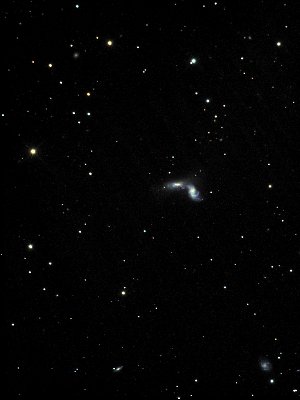
10-inch Newtonian, ST2000XM, 52:20:20:20 This image had a lot of things working against it - gusty winds, poor seeing, and light streaks because the back of my tube was pointed toward the LED on the camera power supply. It worked out surprisingly well considering all the difficulties. The horizontal galaxy toward the left is NGC 3396 and the one hanging down to the right is 3395. Some distortion is evident but they are probably fairly early in their interaction. The galaxies at the bottom of the field, IC 2608 near the center and IC 2604 in the right-hand corner, are worth a long look. IC 2604 has a very heavy arm with a sharp dog-leg. |
|
|
|
|
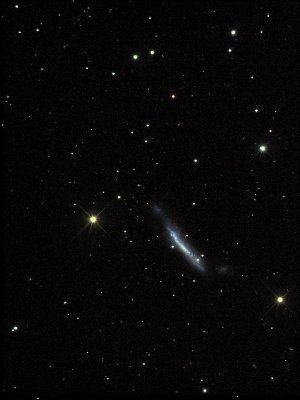
10-inch Newtonian, ST2000XM, 60:20:20:20 NGC 3432 and its dwarf companion, UGC 5983, off the lower right tip, make up Arp 206. The knot of material at the upper left end of 3432 is not a separate galaxy but just a nearly detached segment of the primary galaxy. It is believed that this pair has only recently interacted and there may be more to come. Just wait a few million years and check back! |
|
|
|
|
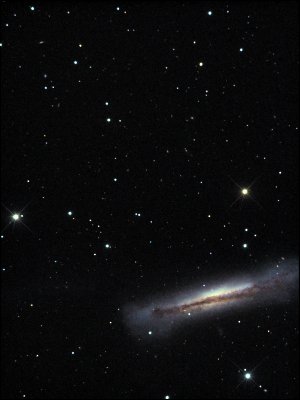
10-inch Newtonian, ST2000XM, 120:30:30:30 NGC 3628 is sometimes called the Hamburger Galaxy, for obvious reasons. Along with M65 and M66, it makes up the Leo Triplet. For a wide-field view of the entire Triplet, click here. I must apologize for the poor presentation of NGC 3628. The offset to the right was deliberate because I wanted to show as much as possible of the plume which exits near the east (left) end. However, I should not have bothered. The plume needs much more then two hours exposure to make it easily visible. It is barely detectable in the color images and, while seen more easily, still very faint in the Monochrome negative image linked below. The galaxy is a pretty object and I would have been better off to have just centered it. There is also a plume of material with some compact objects below the galaxy center, perpendicular to the primary axis. At least one of the objects is a quasar. This feature has been studied extensively in an effort to determine what is associated with NGC 3628 and what is foreground or background. |
|
|
|
|

10-inch Newtonian, ST2000XM, 96:32:32:32 Arp 104 is the galaxy pair in the upper left of the field. The upper galaxy is NGC 5218 and the lower is NGC 5216. They are connected by an obvious bridge. A very faint plume fans out above NGC 5218 and a plume or jet exits from the core of NGC 5216. This is a very complex and interesting object. The pair is also known as Keenan's System. NGC 5205 is near the lower right edge of the field. Both
Megastar and NED list the morphology as |
|
|
|
|
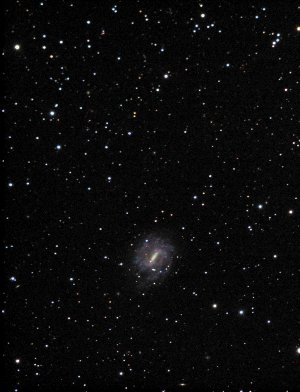
10-inch Newtonian, ST2000XM, 100:30:30:30 NGC 5964 is an attractive barred spiral. The bar is long and skinny, and very prominent. This galaxy is seldom imaged, probably because of the magnitude and small size. |
|
|
|
|
 Arp 1 (NGC 2857) and Arp 285 (NGC 2854 & 6) 10-inch Newtonian, ST2000XM, 100:25:25:25 Arp 1 is the very symmetrical spiral just above and right of center. It is in Arp's class Low Surface Brightness Spirals, while the standard classification is SA(s)c. It is a truly beautiful galaxy. The bright pair in the lower right corner is Arp 285. The lower member is NGC 2854 and the upper is 2856. NGC 2854 is a fairly normal barred spiral, with hints of a long tail curving off to the south and an even fainter tail heading toward 2856. This is easiest to see in the negative image. NGC 2856 is the strange one, with a jet taking off from the core, perpendicular to the axis, and then hooking to the NNW. Dr. Arp's 200-inch photo had much greater resolution, clearly showing several tiny knots in the jet, but this image is deeper. The 200-inch photo shows a shorter jet, without the hook. There are a host of other galaxies in this field, the brightest being UGC 5016, just inside the left edge. It is listed as magnitude 15.2. |
|
|
|
|
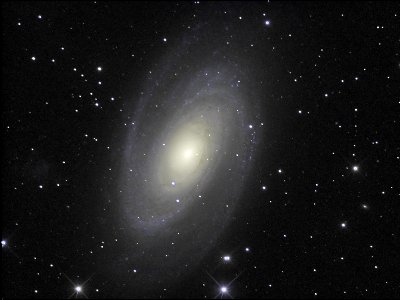
10-inch Newtonian, ST2000XM, 60:20:20:20 M81 is a big bright object, easy to image, A previous wide field image with my AT66 shows the trio of the M81, M82, and NGC 3077. The very faint smudge to the left of M81 is UGC 5336, an Im galaxy with a very low surface brightness. There is a wealth of information available on M81. It is one of the closest galaxies outside our local group, it is believed to have a super-massive black hole at the core, and only one supernova has been seen in this galaxy but it was one of the brightest of the 20th century. Any astronomy text or internet search will give you plenty of material about this galaxy.
|
|
|
|
|
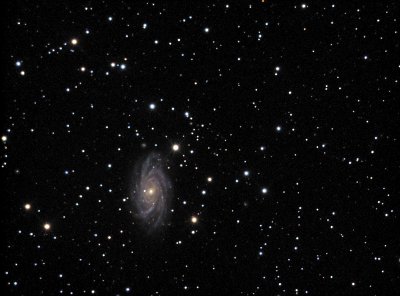
10-inch Newtonian, ST2000XM, 75:24:24:24 NGC 2336 is a very pretty little barred spiral. The bar, while visible, is not very prominent. At 80 degrees N declination, it is in a difficult position to image depending on the type of telescope. While there are lots of images on the internet, there is very little information of general interest.
|
|
|
|
|
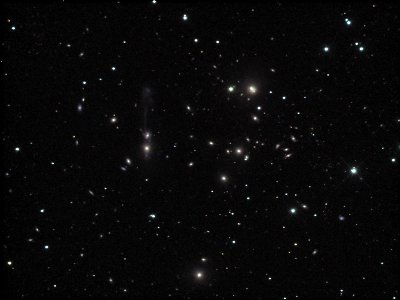
10-inch Newtonian, ST2000XM, 100:30:30:30 Arp 105 is the object just left of center which looks somewhat like an electric guitar. The brighter galaxy at the lower end is NGC 3561 and the distorted galaxy just above it is NGC 3561A. The tiny little blue knot just below 3561 is known as Ambartsumian's Knot. The plume and several of the other knots and jets were cataloged by Vorontsov-Velyaminov, in 1959, as VV 237b-f. The Sat button below shows a highly saturated view of Arp 105 which emphasizes the color range in this object -- slightly bluish becomes bright blue, yellowish becomes bright yellow, etc. This entire field is within the boundaries of Abell Galaxy Cluster 1185. This cluster has 52 identified members within a 28' diameter. The brightest yellowish galaxy to the right and slightly above Arp 105 is NGC 3550. Just below it is CGCG 156-2 and then, in a row heading down and slightly left, are NGC 3553, 3552, and 3554. The last NGC galaxy in the image is 3558, at the bottom center. |
|
|
|
|
 M105 Group (NGC 3379, 3384, and 3389) 10-inch Newtonian, ST2000XM, 48:16:16:16 M105 (NGC 3379) is the large yellow elliptical galaxy just right of center. It is known to contain a super-massive black hole. NGC 3384 is the predominately white barred spiral above and to the left of M105, and NGC 3389 is the smaller spiral below and slightly left of the other two galaxies. NGC 3384 is classified as SB(s)0-. The bar is very short and perpendicular to the primary axis of the galaxy, and the "star" right next to the bar, toward M105, is actually a quasar. The spiral nature of NGC 3384 is not obvious. It may or may not be a companion to M105 but is near it in space. NGC 3389 is classified as SA(s)c. To me, the (pec) designation could easily have been added, since it does not look like a normal spiral. Red shift data indicates that it is a background object, unrelated to the other two galaxies. |
|
|
|
|
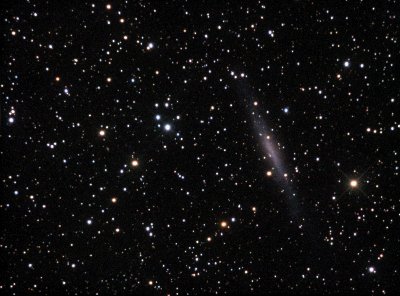
10-inch Newtonian, ST2000XM, 90:28:28:28 This galaxy is seldom imaged, probably because of its low surface brightness. It was invisible in a 10 second Find image, although I knew it was there because of the star patterns. 90 minutes of exposure was barely enough to produce a decent image, and two or three times as much would be better. This image just shows hints of the long extensions to the north and south. Gusty winds and very poor seeing were really bloating the stars, so I decided that it was not worth investing any more time in it. The classification is SA(s)d sp. It might look similar to NGC 253 or 247, both far more impressive objects, if viewed from a similar angle. We are seeing this one nearly edge-on. |
|
|
|
|
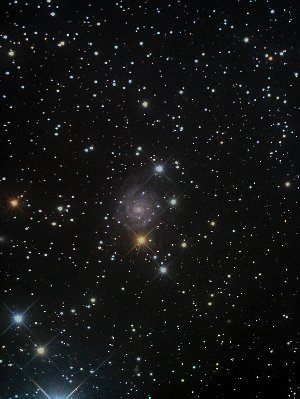
10-inch Newtonian, ST2000XM, 90:24:24:24 IC 239 is a beautiful little face-on barred spiral nestled in a field of bright, colorful stars. The bar is very short. Considering what a gem it is, it is seldom imaged. A Google search only turns up six images. A search for any of the other objects I imaged this month generates many pages of images. The IC designation, low surface brightness, and bright stars apparently discourage a lot of imagers but, as you can see, a lot can be captured with a modest exposure and a small telescope.
|
|
|
|
|
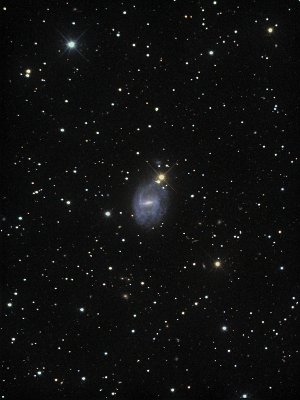
10-inch Newtonian, ST2000XM, 90:24:24:24 NGC 7741 is a barred spiral with a bright central bar and some very blue, indistinct, and overlapping arms. The small galaxy just above the N end has MAC and GALEX designations but no listings in more common catalogs. There are lots of tiny galaxies throughout the field. To me the most interesting is a tiny pair about 10.3' S of 7741 that looks like a micro version of the Antennae. It does not appear to be listed in any catalog but can be seen in the NED image for 2MASX J23434806+2555370, about 1.3' SSW. When I started this image, it was windy and the seeing was very poor but both improved a lot after 45 minutes or so. The major technical problem with this image, and some of the other images made over the next couple of nights, is the egg-shaped stars. I believe it was the result of focuser flex or "droop", because it was worst in the images that were taken near the zenith. Images made with the camera hanging below the tube were much better than those taken when it was directly off to the side, putting the most force perpendicular to the tube. |
|
|
|
|
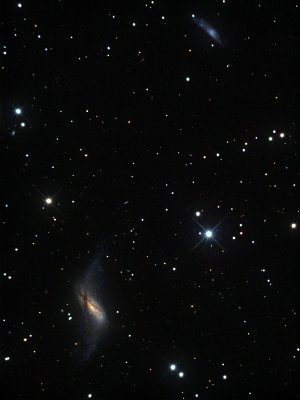
10-inch Newtonian, ST2000XM, 100:30:30:30 NGC 660 is in the lower-left corner of the field. The very blue, unsymmetrical galaxy in the upper-right is UGC 1195. NGC 660 is in the barred spiral class but it is also one of the very rare Polar Ring galaxies. These galaxies are thought to be the result of a collision where one galaxy passes through the center (or near to it) of the other galaxy. The result is typically a starburst galaxy and a ring with little or nothing inside it. The Cartwheel elsewhere on this page is a much smaller and fainter, but even more obvious, example. UGC 1195 is classified as an Im galaxy but it looks to me more like a highly disturbed, extraordinarily blue spiral. |
|
|
|
|

10-inch Newtonian, ST2000XM, 100:30:30:30 NGC 1530 is yet another barred spiral -- I particularly love them -- but still very different than the other examples on this page. It is also a low surface brightness galaxy, and reminds me of some of the Arp galaxies on my other site (www.338arps.com). The area around the core, and the bar itself, are very complex and the S arm is split. The professional literature often refers to the core as a mini spiral. Compared to many of the other galaxy images on this page, there is a real absence of background galaxies. |
|
|
|
|
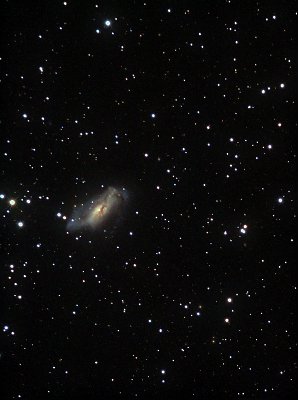
10-inch Newtonian, ST2000XM, 100:30:30:30 NGC 2146 is a peculiar barred spiral. It is a starburst galaxy and its condition is believed to be the result of a collision or close encounter with another galaxy. One candidate, NGC 2146 A, is just out of this field. NGC 2146 is offset to one side simply because I could not find a good guide star with it centered. This is such an interesting and unusual galaxy that there are many excellent images available but most with telescopes larger than mine. I was pleased to see what could be done with a 10-inch aperture and a moderate exposure time.
|
|
|
|
|

10-inch Newtonian, ST2000XM, 72:24:24:24 NGC 470 is the smaller spiral in the center and NGC 474 is the large peculiar spiral to the left. Together they make up Arp 227, the best example of Arp's "Concentric Rings" class. What appear to be two tiny stars on the lower edge of NGC 470 are instead quasars. There is also a quasar right by the core but I have not been able to make it visible in the glare. For a thorough discussion of Arp 227 and concentric ring galaxies, see The Arp Atlas of Peculiar Galaxies -- A Chronicle and Observer's Guide, Jeff Kanipe and Dennis Webb. The larger spiral to the right of the bright star, in the lower-right corner, is NGC 467. There is an obvious edge-on galaxy between 467 and the bright star, but I am unable to locate it in any catalogs I've searched except for the Mitchell Anonymous Catalog. It shows in images of the area but not in any other listings. Further left, just below the second star, is MCG +0-4-83, another edge-on spiral. |
|
|
|
|
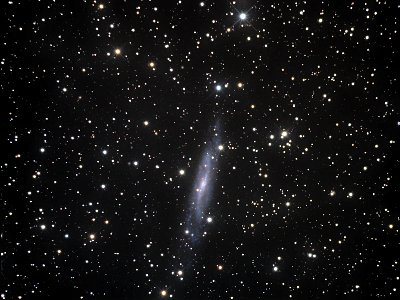
10-inch Newtonian, ST2000XM, 80:28:28:28 NGC 7640 is a barred spiral seen at a low angle. From our viewpoint, the bar is not easy to identify. It has long looping arms with lots of star formation. Note very faint loop at the bottom of the field, and the thin dust lane going through the core. The latter is best seen on the full size image. |
|
|
|
|
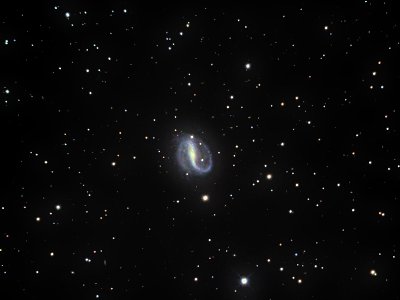
10-inch Newtonian, ST2000XM, 80:24:24:24 NGC 7479 is an unusual barred spiral, and has also been found to be a Seyfert galaxy. These galaxies are thought to contain massive black holes. 7479 has a large number of star forming regions, or knots, especially in the W (right) arm. |
|
|
|
|
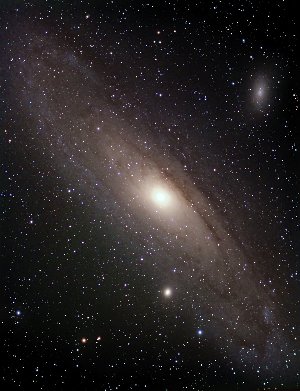
Astro-Tech AT66ED, ST2000XM, 80:28:28:28 minutes, 99' x 76' M31 (NGC 224), the Andromeda Galaxy, is one of the best known astronomical objects, certainly the best known object outside our own galaxy. It is easily seen with binoculars even in light polluted skies and is an easy naked-eye object in dark skies. M32 (NGC 221) is the small, bright galaxy directly below the core of M31, and M110 (NGC 205) is the somewhat peculiar galaxy toward the upper right. M110 shows a surprising amount of detail around the core, especially considering that the telescope is only 66 mm. in diameter. The tidal bridge between M31 and M110 can also be seen. The brightest blue clump near the SW (bottom right) end of M31 is NGC 206, a "knot" of stars in M31. This image was shot in my light polluted back yard. The biggest challenge for imaging in such skies is dealing with gradients -- the variation in brightness across the image due to sky brightness. I was able to process most of it out but the image shows a greenish background toward the lower left. I was not able to get rid of this without losing important parts of the galaxy itself. |
|
|
|
|
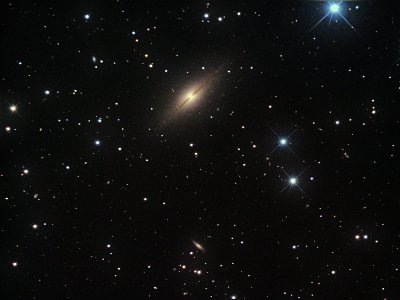
10-inch Newtonian, ST2000XM, 64:24:24:24 NGC 7814 is seen very nearly edge-on, but at just enough of an angle that some of the interior dust lanes can be seen. They look like faint streaks parallel to the equatorial dust lane, and are best seen in the full size image. The only other galaxies of any size in this field are IC 5381, directly below NGC 7814 near the bottom, and CGCG 456-27, to the left of 7814 about halfway to the edge. However, this field has an exceptionally large number of tiny, faint galaxies. Many of these are clustered around 7814, some even showing through it, but many more are found throughout the field. |
|
|
|
|
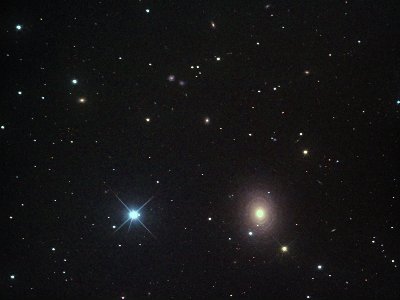 NGC 488, 486, 490, 492, and 500 10-inch Newtonian, ST2000XM, 72:28:28:28 NGC 488 is the most prominent galaxy, below and right of center. It is an SA galaxy with delicate arms spiraling out from the core, encircling it several times. NGC 490 is the first easily visible galaxy up and left from 488. Continuing on the same line, the next two encountered are NGC 486 and 492, which make a neat pair. It isn't obvious whether they are interacting or not. Finally, NGC 500 is about half way from this pair to the left edge, down just a little. Typical of any field in this part of the sky, there are a huge number of small, faint background galaxies. This is not a very good image. I could not get my tracking stabilized in RA and, as a result, the stars all show noticeable elongation. |
|
|
|
|

10-inch Newtonian, ST2000XM, 60:20:20:20 NGC 428 is certainly a peculiar galaxy, although it did not make the Arp catalog. It is very blue and full of star-forming regions. It is believed that it may have "swallowed" another galaxy in the recent past, leading to the burst of star formation and the disturbed shape. There are several loops or bubbles, the most obvious being the large one on the NW edge. The field is full of background galaxies. Two of the most interesting are in the Low Surface Brightness class. UGC 772, near the bottom of the field on the left side, is fairly obvious. LEDA 135629, about 4.5' north of the core of 428, is extremely faint. It can just be seen in this thumbnail but is a little easier on the half and full size views. The magnitude is listed at 16.1, and I can find no references to a size. It is fairly large and I would estimate the diameter at a bit over 2 arc minutes, resulting in a very low surface brightness. |
|
|
|
|

10-inch Newtonian, ST2000XM, 48:16:16:16 NGC 5907 is a nice example of an edge-on galaxy. It is bright and easily imaged. Megastar lists the dimensions as 12.9' x 1.3'. There is a lot of texture and detail in the dust lanes, and a full range of colors from dark brown through yellow and white to the blue of the outer arms. We appear to be looking at this galaxy from just above its galactic plane. The core is peaking out on the east side while fully obscured on the west. I was pleased with this image and consider it one of my better ones. However, to see a truly spectacular image of NGC 5907, check this link: http://apod.nasa.gov/apod/ap080619.html. It shows an Astronomy Picture Of the Day with an 11.35 hours of total exposure through a 20-inch telescope. The galaxy is encircled with streams believed to be the remains of a tidally disrupted previous companion. There is evidence that our Milky Way has some similar remains but they are obscured from our location; the evidence is based on careful star counts and proper motion measurements. The only obvious galaxy nearby is KUG 1513+566, toward the upper right corner. There are, however, a huge number of tiny background galaxies in the image. In one arbitrary square area about 2 arc minutes on a side, I counted 6 stars and 36 galaxies. I believe that ratio is fairly typical throughout the image. I've included a negative monochrome image if you want to make your own counts. |
|
|
|
|
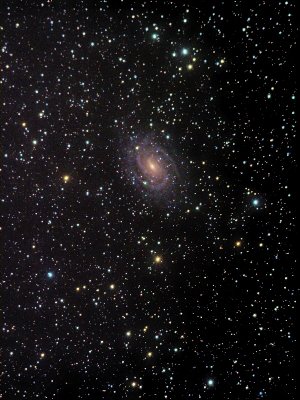
10-inch Newtonian, ST2000XM, 120:36:36:36 NGC 6384 is a barred spiral, with a fairly short and diffuse bar, probably not unlike our Milky Way in appearance. Among the large, bright galaxies, it is one of the closest to the plane of the Milky Way. Because of this, our galaxy would look very similar to NGC 5907 (above) if viewed by an observer in NGC 6384. Because of its proximity to the Milky Way, NGC 6384 has a very rich complement of foreground stars but, unlike the NGC 5907 field above, it is very hard to find any background galaxies. This image was made under marginal conditions and does not have the crispness typical of most of my images. The sky was very moist and hazy, and the wind was very brisk. |
|
|
|
|

10-inch Newtonian, ST2000XM, 120:30:30:30 NGC 3193 is the elliptical galaxy above the center of the field. With NGC 3190, the nearly edge-on spiral, and NGC 3187, the blue dog-leg galaxy, it completes Arp 316. NGC 3185, the spiral in the lower right corner, is not part of the Arp group but is an interesting galaxy. It has an extremely faint yellowish halo twice the diameter of the bright part of the galaxy. Both 3190 and 3187 show obvious evidence of interaction. On close inspection, this image shows a wide band of material connecting 3193 and 3190, and a narrower U-shaped band from the SW end of 3187 to the S side of 3190. There are many more galaxies in the field. Four of the more interesting are the clumpy irregular SDSS_J101832.71+215236.4 about 2' SE of 3193, the tiny edge-on 2MASXJ10181187+2151294 between 3193 and 3190, 2MASXJ10174317+2150588 on the SW tip of 3187, and LSBC D500-05 about 20% of the way up from the bottom and just E (left) of center. |
|
|
|
|
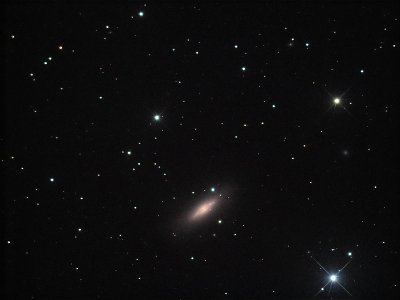
10-inch Newtonian, ST2000XM, 50:25:25:25 I'm identifying NGC 5866 as M102 at some risk. For many years, M102 was considered a "missing" Messier object -- never correctly cataloged -- but in recent years there seems to be fairly wide agreement that it is really NGC 5866. However, the debate continues. The extremely narrow dark lane (galactic disk) bisecting the galaxy is its most interesting feature, but the bright flares at both ends of the dark lane are also unusual. This image is shorter and not as deep as the Arp 316 image above, and does not show nearly as many background galaxies. The ones seen aren't especially interesting. M102 was placed off-center in the field so I could find a suitable guide star. |
|
|
|
|
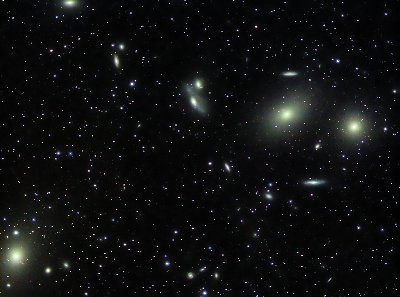 M87 and (Most of) Markarian's Chain Astro-Tech AT66ED, ST2000XM, 90:25:25:25 minutes, 73' x 99' This image is near the center of the great Virgo Galaxy Cluster. M87 is the elliptical galaxy in the lower left corner. The string of galaxies running from M84 near the right edge of the field to NGC 4473 right on the top left edge is most of what is known as Markarian's Chain. NGC 4477, out of the field to the top, is definitely considered part of the chain, and some consider M88, almost another degree past 4477, to be part of it, too. Since I wanted to include M87, this was as many as I could fit in. The other larger chain galaxies are M86, the elliptical left of M84, NGC 4438 and 4435, the pair just above center (which together make up Arp 120), and NGC 4461 and 4458, the smaller pair midway between NGC 4438 and NGC 4473. There are a total of 18 NGC galaxies plus a number of IC galaxies. I can count about 60 galaxies in this field, and many of the fainter "stars" are actually galaxies too tiny to identify. This image was made at Fort McKavett, TX. |
|
|
|
|
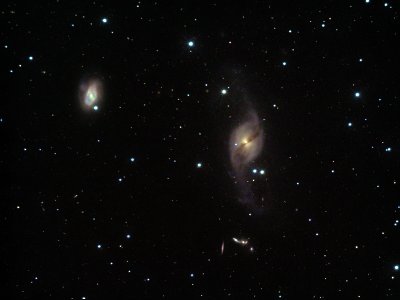 NGC 3718 (Arp 214), NGC 3729, and Arp 322 10-inch Newtonian, ST2000XM, 88:24:24:24 This is a jam-packed field with lots of interesting stuff. The largest galaxy, Arp 214, is like no other. It has an amazing array of loops, bands, tails, and barbs. See The Arp Atlas of Peculiar Galaxies for a diagram highlighting some of the faintest features. Just south of it is Arp 322, a chain of five tiny galaxies, three appearing to be in contact. This group is also known as Hickson 56. And to complete the package, NGC 3729, toward the upper left, is also a very strange object, even though it did not make the Arp catalog. There are many more tiny galaxies scattered throughout the field. |
|
|
|
|
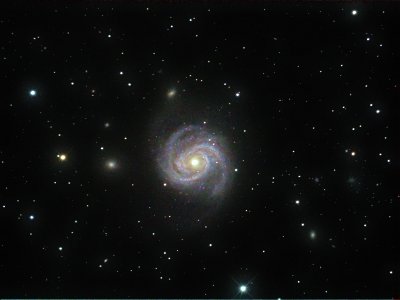
10-inch Newtonian, ST2000XM, 96:32:32:32 Messier 100 is the centerpiece of this image. The small galaxy just above and slightly left of M100 is NGC 4322 and the one directly to the left is NGC 4328. The faint outer halo of M100 appears to connect to both of these galaxies but I'm not sure whether they are believed to be interacting. The faint irregular galaxy near the right edge of the field is MCG+3-32-11. The image contains a number of VCC and Mitchell Anonymous galaxies, plus many tiny background galaxies. |
|
|
|
|
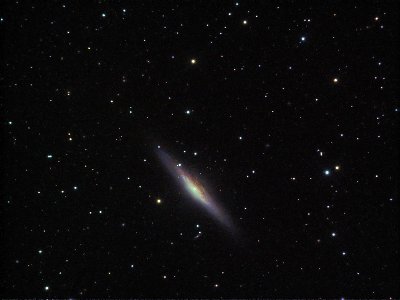 10-inch Newtonian, ST2000XM, 72:24:24:24 This very attractive, nearly edge-on galaxy shows a lot of interesting dust lane texture, especially on the NW side. The bright core just peeks through the arms. This is best seen in the full size version. There are 17 Mitchell Anonymous and one KUG galaxy included in the field. |
|
|
|
|
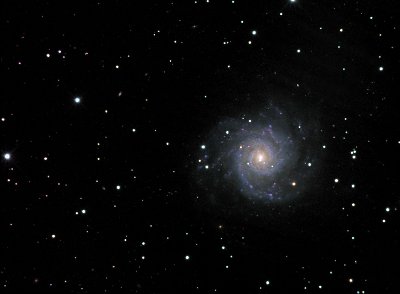
10-inch Newtonian, ST2000XM, 160:48:48:32 This beautiful face-on spiral is about as perfect as they come. The form and colors are wonderful. My image does not show as much faint background structure as you might expect given the length of the exposure. Reflections from Eta Pisces, at 3.6 magnitude and about 1.3 degrees to the SW, made obvious streaks in the image and I had to balance between showing all the faint stuff versus reducing the streaks. There is probably a nut or bolt end somewhere in my tube that is not completely blackened, but I haven't been able to locate it yet. It is not an easy object visually. While it has a fairly high total magnitude of 9.4, it is large and has a low surface brightness. Also, it does not show as much brightening toward the core as do many galaxies. |
|
|
|
|
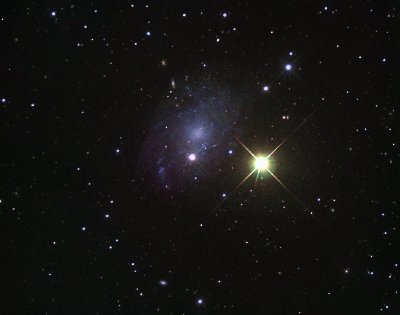
10-inch Newtonian, ST2000XM, 120:40:40:32, 21' x 26.6' This beautiful galaxy does not get much attention and is seldom imaged. The adjacent 7th magnitude star adds a little to the difficulty but also certainly adds to the attractiveness of the field. The galaxy is extremely blue and has a large number of very blue star-forming regions in the arms. It is one of the lowest surface brightness galaxies known and has very little dust, making background galaxies visible through it fairly easily. It contains over 230 supernova remnants. |
|
|
|
|
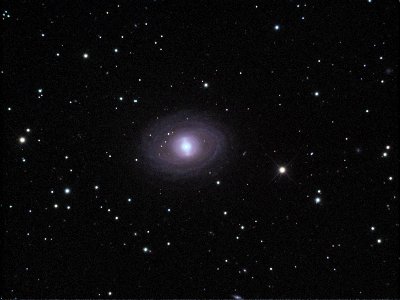
10-inch Newtonian, ST2000XM, 64:24:24:24 This barred spiral in Fornax is, unlike NGC 45 above, frequently imaged and there are many great images of it available on the web. The delicate spiral arms go through almost an entire 360 degrees, and contain many tiny bright blue star-forming regions. |
|
|
|
|
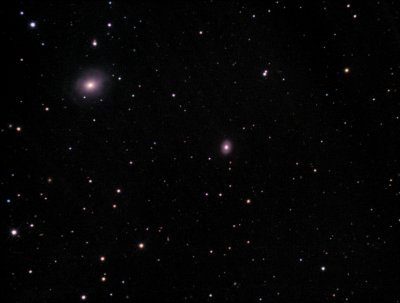
10-inch Newtonian, ST2000XM, 100:32:32:32 NGC 7585 is included in the Arp Atlas of Peculiar Galaxies as Arp 223. It's the largest galaxy in the field, in the NE corner. The smaller galaxy near the center of the field is NGC 7576. There are a number of faint background galaxies, including four MAC's. Megastar shows a quasar right on the southwest edge of the galaxy but there are not enough "roadmap" stars for me to tell whether it is visible in this image or not. |
|
|
|
|
 M51 (NGC 5194 and 5) 10-inch Newtonian, ST2000XM, 28:14:12:12, 15.7' x 11.8' This is a really mediocre image of M51, but it is such a beautiful object that even a poor image is attractive. The time was much too short because M51 went behind the trees, and I lost a lot of individual exposures due to wind. I'll have to wait until next year to improve it from my location. This image has the long axis running N-S. I had to shift my field to get a decent guide star, and then crop Because of the crop, the field is smaller than my usual for this scope/camera combination. The spiral primary is NGC 5194 and the unusual barred spiral companion is NGC 5195. The pair is included in the Arp Atlas of Peculiar Galaxies as Arp 85. |
|
|
|
|
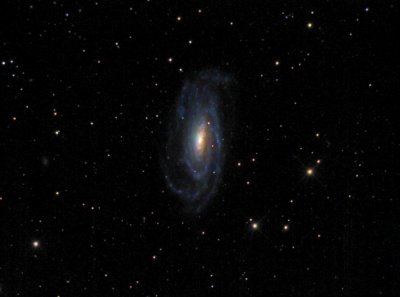
10-inch Newtonian, ST2000XM, 176:40:34:36, 20.3' x 27.4' NGC 5033 is a particularly beautiful and delicate galaxy. The conditions were brutal during the imaging, with frequent 30 mph wind gusts and clouds coming and going, but it did show that my new tube was worth the effort. For a much better version of this object, go to Al Kelly's web site, http://www.kellysky.net. The faint galaxy near the left side of the field is Mitchell Anonymous 1314+3634 and also has an SDSS designation. |
|
|
|
|

10-inch Newtonian, ST2000XM, 152:56:40:40 This grouping shows an amazing spectrum of galaxy colors. The large primary, NGC 5566, is almost pure yellow, the close companion just off the northern tip, NGC 5569, is an equally pure blue, and the distorted galaxy to the northwest, NGC 5560, shows a rainbow of colors. And, to complete the range, the tiny galaxy about halfway to the southeast corner, CGCG 47-19, appears completely white. You'll probably need to look at one of the larger images to tell this one is not a star. The main group of three is included in Halton Arp's Atlas of Peculiar Galaxies as Arp 286. I've included a full-size monochrome negative image which better shows the myriad of tiny background galaxies. |
|
|
|
|
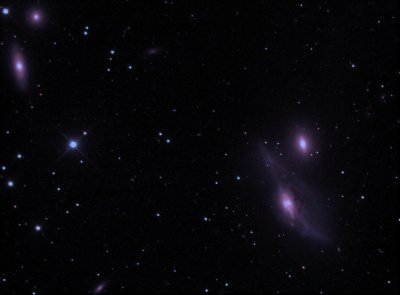
10-inch Newtonian, ST2000XM, 128:32:24:24, 21.1' x 28.6' The primary, NGC 4438, and companion(?), NGC 4435, are also known as Copeland's Eyes and are part of a larger group of galaxies known as Markarian's Chain. The two galaxies in the upper left corner, NGC 4461 and 4458, are also part of the Chain. Other galaxies in the field include IC 3393, near the bottom edge, and VCC 1101, about 9' west of NGC 4461. NGC 4438 includes some unusual features, especially the "wishbone" shaped arm and the strong absorption feature just west of the core. NGC 4438 and 4435 were included in Dr. Arp's catalog as interacting, but more recent studies indicate that NGC 4435 is not involved and that the original interacting galaxies have almost completely merged to become 4438. A negative image is included to better show the background galaxies. |
|
|
|
|
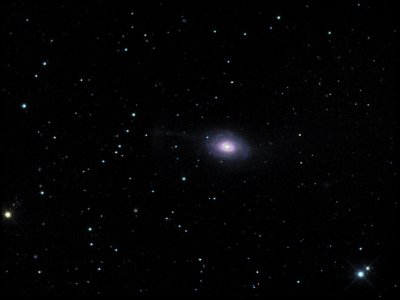
10-inch Newtonian, ST2000XM, 84:32:28:28 NGC 4651 is included in the Atlas of Peculiar Galaxies as Arp 189, and it is certainly peculiar. The jet or tail pointing due east, terminating in an arc, is a feature I have not seen in any other galaxy. For a extremely detailed view of the main part of the galaxy, and a little bit of the jet, go to NGC 4651. Again, I've included a negative image to make it easier to see the host of tiny galaxies in this field. None are shown in Megastar, although many have SDSS designations and at least one is in 2MASX. |
|
|
|
|

10-inch Newtonian, ST2000XM, 112:24:20:20, 21' x 28.3' NGC 6946 is a big colorful galaxy with a beautiful spiral form. It is in the Arp catalog as an example of a galaxy with one heavy arm. It was offset in the field primarily to get a better guide star, but also to show the little barred spiral, Mitchell Anonymous 2032+6000, in the southwest corner. There are a number of background galaxies which show up best in the negative image, but they are hard to find because the density of foreground stars is so high. |
|
|
|
|
 NGC 3623 (M65), 3627 (M66), and 3628 -- together, the Leo Triplet Astro-Tech AT66ED, ST2000XM, 340:28:24:24 minutes, 63' x 92' NGC 3628 is the edge-on galaxy at the top of the field. NGC 3627 (M66) is directly below it, and 3623 (M65) is to the right and up a little. Together, the three galaxies are known as the Leo Triplet, and also as Arp 317. About half of the luminosity and all of the color was acquired at Fort McKavett, and the rest of the luminosity at the Texas Star Party. This is by far my longest image to date, just short of seven hours total. My goal, which has not really been met, was to show the long "tail" exiting from the core of NGC 3628 and continuing east (left) beyond the edge of the field. The tail can be seen in this image but only the first 15' is easily visible and even this part is very faint and noisy. From there to the edge of the field, it is barely above the noise level. |
|
|
|
|
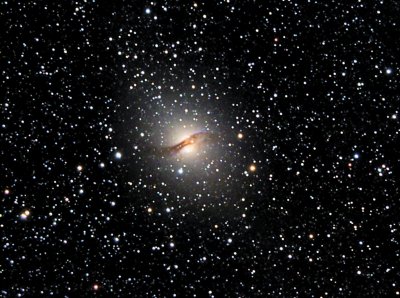
Meade 2045D, ST2000XM, 40:32:24:24 minutes, 45' x 61' NGC 5128 is a very unusual galaxy and, in fact, is included in the Arp Atlas of Peculiar Galaxies as Arp 153. It is also the strong radio source Centaurus A. It contains a huge black hole at the core, which probably triggers the radio emission. It is widely thought to represent the residue from a collision of two galaxies but this remains a source of debate. The image was acquired at the 2009 Texas Star Party. |
|
|
|
|
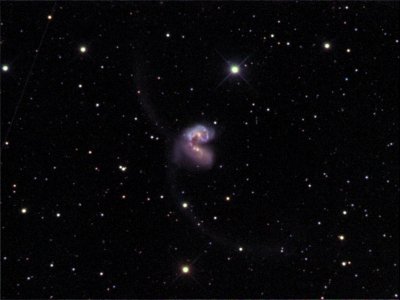 NGC 4038 and 4039 (The Antennae) 10-inch Newtonian and Meade 2045D, ST2000XM, 56:40:30:30 minutes This is the perfect example of interacting galaxies. The collision (or near collision) has distorted the galaxies into truly unusual shapes, triggered a huge burst of star formation, and resulted in the ejection of the two long tails. The blue knots, mostly in the northern member, are regions of intense star formation. This pair is also in the Arp atlas as Arp 244. The luminosity was acquired with my 10-inch Newtonian in May 2008 and the color data was collected using the Meade 2045D at the 2009 Texas Star Party. The short broken track about 3' WNW (right and a little up) from the galaxies is asteroid Welzl (15425). The track is broken because my imaging was stopped several times by passing clouds. |
|
|
|
|
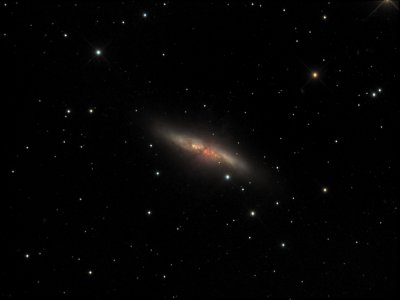
10-inch Newtonian, ST2000XM, 52:30:24:24 minutes M82 is a very unusual object, which is reflected by its alternate catalog designation as Arp 337 in the Arp Atlas of Peculiar Galaxies. This image only hints at the perpendicular filaments which show up strongly in H alpha images, but it clearly shows the mottling and dark lanes near the core. A close examination of the full size image will show that the brighter stars are elongated in the N-S direction. I was fighting a strong, gusty south wind during this image. I had enough luminance images that I was able to discard all those with wind "tails" but had to use some of the less-than-perfect RGB images in order to have enough color data. |
|
|
|
|
 NGC 2685 (Arp 336, Helix Galaxy) 10-inch Newtonian, ST2000XM, 120:36:40:40 minutes Like M82 above, this is one of the Arp Peculiar Galaxies, Arp 336. It is probably the best example of a polar ring galaxy. There are circumferential rings encircling the bright cigar-shaped core, and the whole galaxy is enveloped in a ellipsoidal cloud of stars. Overall, the predominate color is yellow but, in the larger views, blue clusters of young stars can be seen on some of the rings. |
|
|
|
|
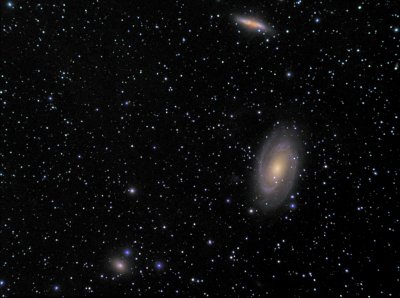
Astro-Tech AT66ED, ST2000XM, 60:20:16:16 minutes, 76' x 102' The three primary members of the M81 group are M81 itself (NGC 3031, right of center), M82 (NGC 3034, near top of field), and NGC 3077 (left of center, near the bottom). In total, there are probably over a dozen members but most are well outside of this field. NGC 2403, shown elsewhere on this site, is one of these. A more detailed image of M82, taken with my 10-inch, is shown above. I suspect that the faint irregulars UGC 5336 about 9' E of the M81 core and the unnamed galaxy due S of M81, almost at the bottom edge of the field, are also members. This is another image from my observatory in West Point, TX. |
|
|
|
|

10-inch Newtonian, ST2000XM, 48:28:16:24 minutes This extremely unusual galaxy is in Dr. Arp's class Material Emanating from Elliptical. I suspect that it may be the result of an elliptical passing through a spiral but you can try to figure it out for yourself. The image shows a yellow elliptical with a blue loop attached, and a tiny reddish knot between them. The galaxy due W of Arp 141, just below the star, is UGC 3705. It appears to be a very turbulent spiral, nearly pure white. My green exposure was less than I wanted because a cloud passed by during the image set and I didn't notice that two exposures were bad until I was home processing them. |
|
|
|
|
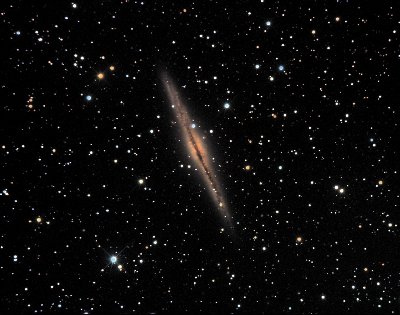
10-inch Newtonian, ST2000XM, 100:32:32:32 minutes NGC 891 has always been a nice object to image. It is about as good an example of an edge-on spiral as there is. |
|
|
|
|
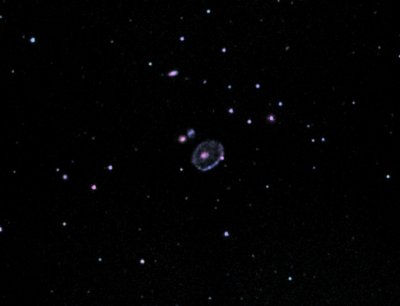 The Cartwheel (ESO 350-40) 10-inch Newtonian, MX716 & ST2000XM, 46:24:34:22 minutes, 11.8' x 15.8' The Cartwheel is an extremely unusual galaxy. It does not have a designation in any of the more familiar galaxy catalogs but is almost certainly a Polar Ring type. The Hubble telescope recently took a spectacular image of this object. The luminosity for my image was taken in 2007 with my StarlightXpress MX716 camera, while the last of the color exposures was completed on 1/1/2009 with my ST2000XM. The conditions were terrible while the color data was being collected and I hope to get some better data next Fall. |
|
|
|
|
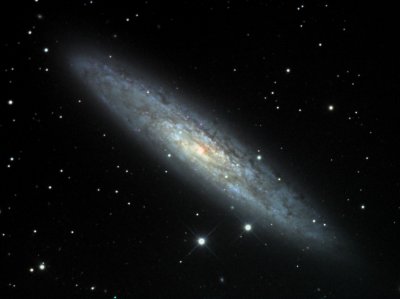
10-inch Newtonian, ST2000XM, 64:24:22:20 minutes, 20.8' x 27.8' This field is approximately 1' less on each side than the normal image because the luminosity was acquired on a different night than the RGB's and I did not reproduce the framing exactly. This is a far-southern object and would be very difficult for imagers north of latitude 40 degrees. It turned out to be one of my best images. |
|
|
|
|
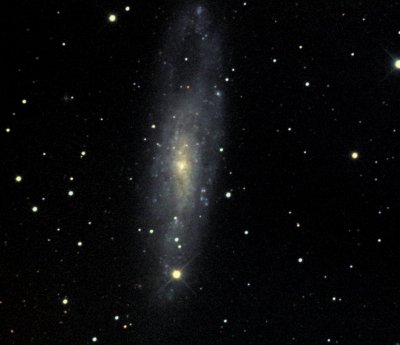
10-inch Newtonian, ST2000XM, 44:32:22:25 minutes, 21.6' x 27.3' This strange galaxy is very similar in size, and very nearby, to NGC 253, which can be seen just above. It is also almost two magnitudes fainter, making it more difficult for visual or CCD observers. I was fighting very strong, gusty winds and increasing haze as this image was acquired. It is not nearly as good as the NGC 253 image; the full size image really shows the deficiencies. |
|
|
|
|

Two versions: This beautiful barred spiral is probably my favorite galaxy. All of the data for the half size image was acquired with the ST2000XM camera, shows a much larger field, and has better resolution, but is noisier. The full size image, combining luminosity from both cameras, shows a smaller field but is much deeper. The Arp Atlas of Peculiar Galaxies -- A Chronicle and Observer's Guide, by Knipe and Webb, has a good discussion of this object. The core of this galaxy is extremely unusual but is so bright that I was unable to show it well in these images. Click this link [Core] to see a 2x monochrome view of the core. |
|
|
|
|
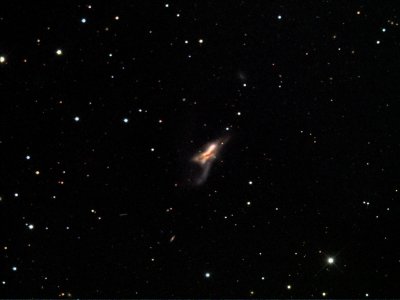 NGC 520 (Arp 157) 10-inch Newtonian, ST2000XM, 60:32:28:28 minutes, 21' x 28.1' NGC 520 is one of the Arp Peculiar Galaxies. It is believed to be two galaxies in collision. Notice the deep red-brown band through the center of the main object and the pale blue tail sweeping off to the south. The small faint galaxy NNW of the primary is UGC 957, and may have been involved in the collision millions of years ago. In the larger images, look for a deep blue "star" about 2' SSW of the blue tail; it is marked with a "V" in the half size image and is actually a quasar, 0121+034. There is a second, even brighter, quasar in the center of the galaxy but the glare obscures it. There is also an asteroid track about 5' SW of the tail. |
|
|
|
|
|
10-inch Newtonian, ST2000XM, 60:32:28:28 minutes Best known as Messier 77, it is also in the Arp catalog. It is a Seyfert galaxy, characterized by their very bright, variable cores and unusual spectra. M77 has a large faint halo -- to me, it looks yellower than the central part of the galaxy, probably meaning that the average star is older. Note the tiny background galaxies that can be seen through the halo, especially in the full size image.
|
|
|
|
|
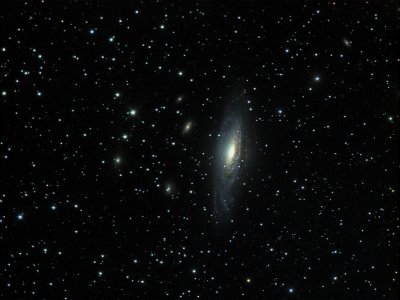 10-inch Newtonian, ST2000XM, 40:32:32:32 minutes This is a beautiful galaxy group, and one of my favorites. The three closest companions, starting at the N end, are NGC 7336, 35, and 37, and the one further to the E (left) is 7340. |
|
|
|
|
 10-inch Newtonian, ST2000XM, 60:28:28:28 minutes M33 is often called the Pinwheel Galaxy. It is very large and has a high total magnitude, but is often a challenging object visually because the surface brightness is fairly low. There are a large number of objects within M33 that have their own catalog numbers. The most prominent is NGC 604, the hot pink area in the upper left of this image. NGC 595 is the smaller hot pink area NW of the core and NGC 592 is the large open cluster midway between the core and the W edge of the field. |
|
|
|
|
|
10-inch Newtonian, ST2000XM, 96:24:24:24 M32 is a companion to the famous Andromeda Galaxy, M31. The entire lower right hand half of the image is a portion of M31. M32 is also in the Arp atlas as Arp 168.
|
|
|
|
|
|
10-inch Newtonian, see below for camera, 50:32:32:32 minutes, 11.1' x 14.7' The W galaxy (a compact E type) is NGC 7317. Moving NE, the close pair consists of NGC 7318A and B. The next galaxy east, with the long tail, is NGC 7319 and the largest member, south of 7319, is NGC 7320. NGC 7320 is much bluer than the other members of the group. This might indicate that it is younger and still in an active period of star formation. Finally, the small ring galaxy to the east, connected to the others with a nearly invisible streamer, is NGC 7320C. All of the members except for 7320C are part of Hickson Compact Group 92. The luminosity image was acquired in 2007 with my StarlightXpress MX716 camera and the RGB images were done with the ST2000XM.
|
|
|
|
|
|
|












